| |
Whoa dogies don’t know about y’all but all this time on the trail I’m gettin’ a bit tuckered. I know a place up the way we can stop off at and rest up a bit. Now we’ll have to leave the wagons here and go in on horseback cause it’s a might tricky. But ol’ Robert Leroy Parker and Harry Longbaugh will be sure to offer us a good time.
Oh, Cookie just brought up a good point. Y’all better leave your valuables on your wagons…we’re just sayin’ can’t be too careful at the Hole-in-the-Wall!
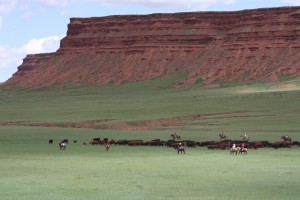 In Southwest Johnson County, Wyoming lying between the Red Wall and Big Horn Mountains is the most famous hideout on the Outlaw Trail, the Hole-in-the-Wall. Between roughly the 1860s and 1910, 30 to 40 outlaws stayed in the secluded spot including Jesse James and Butch Cassidy’s Wild Bunch. In Southwest Johnson County, Wyoming lying between the Red Wall and Big Horn Mountains is the most famous hideout on the Outlaw Trail, the Hole-in-the-Wall. Between roughly the 1860s and 1910, 30 to 40 outlaws stayed in the secluded spot including Jesse James and Butch Cassidy’s Wild Bunch. 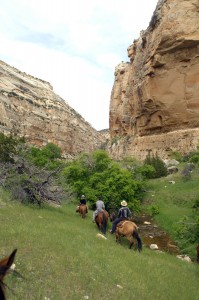 The area was (and still is) isolated taking about a day’s journey by horseback from any semblance of civilization. It is a steep climb to the top of the Wall, but overlooking the country below it is no wonder this location was chosen. With sweeping 360 views the pass was well situated to spot approaching lawmen and the narrowness of the approach made it easy to defend. The grassy plateau at the top and creek bed of the canyon below made it a good spot to graze all the rustled cattle. The area was (and still is) isolated taking about a day’s journey by horseback from any semblance of civilization. It is a steep climb to the top of the Wall, but overlooking the country below it is no wonder this location was chosen. With sweeping 360 views the pass was well situated to spot approaching lawmen and the narrowness of the approach made it easy to defend. The grassy plateau at the top and creek bed of the canyon below made it a good spot to graze all the rustled cattle.
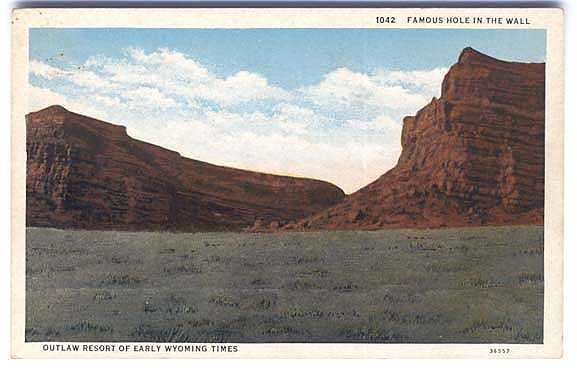 In this area in the 1880s and 1890s, rustlers grazed stolen cattle and provided refuge to outlaws. Inhabitants of the six cabins that stood in the valley were known as the Hole-in-the-Wall Gang. Members of the gang included Bob Smith, Al Smith, Bob Taylor, George Currie, Tom O’Day, and the Roberts Brothers. Later Robert Leroy Parker (Butch Cassidy), Harry Longbaugh (the Sundance Kid), and Harvey Alexander Logan (Kid Curry). In this area in the 1880s and 1890s, rustlers grazed stolen cattle and provided refuge to outlaws. Inhabitants of the six cabins that stood in the valley were known as the Hole-in-the-Wall Gang. Members of the gang included Bob Smith, Al Smith, Bob Taylor, George Currie, Tom O’Day, and the Roberts Brothers. Later Robert Leroy Parker (Butch Cassidy), Harry Longbaugh (the Sundance Kid), and Harvey Alexander Logan (Kid Curry).
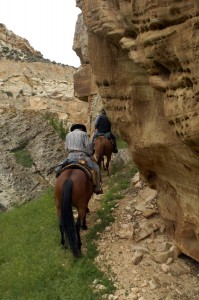 As we make our way up the rugged trail, let me introduce y’all to our hosts. Robert Leroy Parker, born in 1866, was the son of devout Mormons. He was led into a life a crime by Mike Cassidy and adopted the name George Cassidy, some believe as a way of not bringing shame on his family. In 1885, Mike Cassidy disappeared after killing a Wyoming rancher. Parker took a job with Charlie Crouse. Crouse operated a ranch in Brown’s Hole and a butcher shop in Rock Springs, Wyoming. It was alleged Crouse sold meat from cattle he rustled. It was while employed by Crouse, Parker adopted the name Butch. As we make our way up the rugged trail, let me introduce y’all to our hosts. Robert Leroy Parker, born in 1866, was the son of devout Mormons. He was led into a life a crime by Mike Cassidy and adopted the name George Cassidy, some believe as a way of not bringing shame on his family. In 1885, Mike Cassidy disappeared after killing a Wyoming rancher. Parker took a job with Charlie Crouse. Crouse operated a ranch in Brown’s Hole and a butcher shop in Rock Springs, Wyoming. It was alleged Crouse sold meat from cattle he rustled. It was while employed by Crouse, Parker adopted the name Butch.
By 1886, Parker was living near Meeteetse, Wyoming under his real name. It is believed 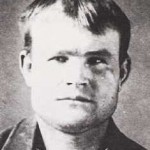 he participated in the robbery of the San Miquel Valley Bank in Telluride in June of 1889. The Telluride robbery saw the introduction of a new tactic used by members of the Wild Bunch. Along the escape route, the robbers stationed fresh horses. The pursuing posse would have to continue the chase on tired horses, therefore the robbers could elude capture. he participated in the robbery of the San Miquel Valley Bank in Telluride in June of 1889. The Telluride robbery saw the introduction of a new tactic used by members of the Wild Bunch. Along the escape route, the robbers stationed fresh horses. The pursuing posse would have to continue the chase on tired horses, therefore the robbers could elude capture.
During this time, Parker continued to engage in rustling in Wyoming. He was arrested for horse stealing near Meeteetse and sentenced in 1894 to the State Penitentiary (in Laramie). He was released early in 1896 and returned to a life of crime using a series of hideouts including Robbers’ Roost in southern Utah, Brown’s Hole in northwest Colorado, and of course the Hole-in-the-Wall.
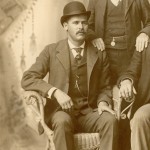 Our second host is Harry Longabough. Born in Pennsylvania in 1867, he moved to Colorado with his family. By age twenty, Longabough was working as a cowboy for the N Bar N owned by the Neidringhaus Brothers in Culbertson, Montana. In 1887, out of work and drifting he stole a horse, gun and saddle from Western Ranches, Ltd, owner of the Three V’s near Sundance, Wyoming. He was arrested and pleaded guilty, and was sentenced to 18 months in the Sundance jail. He was pardoned by Governor Thomas Moonlight. Longabough drifted to Bell Fourche, South Dakota, and there as a result of his bravado about the time spent in the Sundance jail he earned the appellation of Sundance or Sundance Kid. Our second host is Harry Longabough. Born in Pennsylvania in 1867, he moved to Colorado with his family. By age twenty, Longabough was working as a cowboy for the N Bar N owned by the Neidringhaus Brothers in Culbertson, Montana. In 1887, out of work and drifting he stole a horse, gun and saddle from Western Ranches, Ltd, owner of the Three V’s near Sundance, Wyoming. He was arrested and pleaded guilty, and was sentenced to 18 months in the Sundance jail. He was pardoned by Governor Thomas Moonlight. Longabough drifted to Bell Fourche, South Dakota, and there as a result of his bravado about the time spent in the Sundance jail he earned the appellation of Sundance or Sundance Kid.
Sundance moved north and worked for a period of time at the Bar U in Alberta and for a short period of time in the saloon business at Grand Central Hotel in Calgary. He then returned to Montana and the N Bar N at its Rock Creek unit.
In 1892, Sundance was implicated with Tom McCarty (an acquaintance from Colorado), Matt Warner, and Butch Cassidy, in the robbery of the Great Northern westbound #23 near Malta, Montana. By 1896, Sundance was reported to be in the Baggs and Dixon, Wyoming area.
On June 28, 1897, Sundance along with George Currie, Kid Curry, Walt Punteney and Tom O’Day participated in the robbery of the Butte County Bank in Belle Fourche, South Dakota. The bank was a huge target. After the railroad arrived, the town became prosperous as being a loading point for cattle and later sheep. The bank was so prosperous it was acquired in 1903 by Clay, Robinson, and Co., the largest commission agents in the country. John Clay managed the Three Vs, the ranch Sundance had stolen a horse and saddle beginning his criminal career.
The robbery and subsequent pursuit by the law was a comedy of errors with one man, O’Day, being found in a privy behind on of the numerous saloons after O’Day’s horse decided to leave town without him. It took until September for Sheriff John Dunn, Carbon County, Montana, and a small posse to catch up to the other three near Musselshell River. In the ensuing shootout, Kid Curry’s horse was shot through the neck and Curry was shot through the wrist. Curry leaped onto the horse and galloped away, only to have the horse drop dead. All three were arrested and transported to Deadwood Jail. There they escaped, stole horses and gear. They eluded capture on foot, losing horses and swag they had stolen. Ultimately, they made it back to the Hole-in-the-Wall, where as a result of their adventures, they were accepted as full members of the Hole-in-the-Wall gang.
Harvey Logan, Kid Curry, might be takin’ up residence at the Hole unless he’s out…on 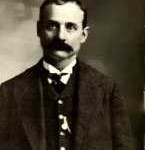 business. Harvey Alexander Logan was born in Iowa in 1867. After their mother died the four Logan boys, Hank, Johnnie, Lonny, and Harvey moved to Missouri and lived with an aunt. With Johnnie and Lonny, and a cousin, Harvey Logan left home to trail cattle from Texas to Colorado. The four ultimately wandered to the Hole-in-the-Wall where they met George Currie and adopted the last name “Curry.” business. Harvey Alexander Logan was born in Iowa in 1867. After their mother died the four Logan boys, Hank, Johnnie, Lonny, and Harvey moved to Missouri and lived with an aunt. With Johnnie and Lonny, and a cousin, Harvey Logan left home to trail cattle from Texas to Colorado. The four ultimately wandered to the Hole-in-the-Wall where they met George Currie and adopted the last name “Curry.”
In 1894, the “Curry” Brothers established a ranch near Landusky, Montana, in what is now Phillips County. The town was named after Powell “Pike” Landusky who discovered gold in the area. Not long after their arrival the brothers had a falling out with Landusky due to the fact Lonny impregnated Landusky’s daughter, Elfie. For some reason, Landusky blamed Harvey for the deed.
Now just to warn y’all, Harvey’s a might quick tempered, especially when he’s had a bit of alcohol to raise his blood temperature. And after enjoying too much Christmas Spirit at “Jew Jake’s” Saloon, Landusky and Harvey decided to settle their differences in a way not keeping with the Season. Harvey, being younger, had the advantage and after bringing Landusky down he proceeded to beat the town founder’s head to a pulp against the floor. Lonnie and another friend kept spectators at bay using their side arms. Landusky reached for a revolver from his pocket. Harvey was handed a gun and shot Landusky dead. Eleven witnesses swore it was self defense, but the brothers fearing Harvey wouldn’t receive a fair trial departed town on a stolen buckboard.
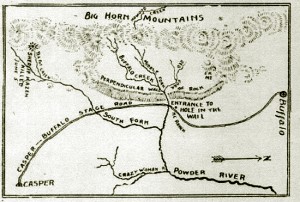 On the outlaw trail, Harvey fell in with Butch and Sundance and participated in the Wilcox and Tipton, Wyoming train robberies… On the outlaw trail, Harvey fell in with Butch and Sundance and participated in the Wilcox and Tipton, Wyoming train robberies…
A trestle across the Union Pacific near Wilcox, Wyoming at 1:00 a.m., June 2, 1899, forces the Overland Flyer to halt. Men wearing masks made from white napkins, possible stolen from the Harvey House Restaurant, boarded the train. One of the men after unsuccessfully forcing the engineer to pull the train forward, pulls the train forward himself. The trestle is dynamited to prevent the second section of train from catching up. The train is pulled forward two miles and stopped.
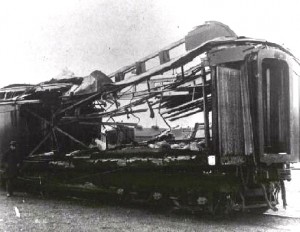 There the express car was surrounded, and the attendant, E.C. Woodcock, was ordered to open the door. He refused. The car was blown up. Woodcock suffers a concussion from the blast and can’t remember the combination to the safe. The gang blows up the safe and stole $30,000, some of the bank notes being scorched by the explosion or stained with raspberries also in the car. There the express car was surrounded, and the attendant, E.C. Woodcock, was ordered to open the door. He refused. The car was blown up. Woodcock suffers a concussion from the blast and can’t remember the combination to the safe. The gang blows up the safe and stole $30,000, some of the bank notes being scorched by the explosion or stained with raspberries also in the car.
Even though the men were masked immediate suspicion falls on the Wild Bunch. Other newspapers identified the culprits as the Roberts brothers and reported the robbers to be George Currie and the Roberts brothers. It is now believed the name “Roberts” was used by Sundance and Harvey Logan. Authorities believed some of the robbers were headed for the Hole-in-the-Wall. Posses gave chase. Near Teapot Creek some of culprits were cornered by a posse led by Converse County Sheriff Joe Hazen. In the ensuing fire fight, Sheriff Hazen was killed and the train robbers made their escape by swimming across the river.
On August 29, 1900, train robbers, using the same modus operandi robbed the Union Pacific No. 3 Train near Tipton, Wyoming of $50,000 in gold. Woodcock, if you can believe it, was again the express car attendant. This time he opened the door. The robbers were pursued by a posse led by Sheriff McDaniel of Carbon County, Sheriff Peter Swanson of Sweetwater County and United States Marshal Frank Hadsell until the tracks of the robbers were obliterated by a rain. Five years later an employee on a construction crew for the Farris-Haggarty tramway discovered near the head waters of Cow Creek thee bags in which the money from the Tipton Robbery had originally been held.
Although successful the Wilcox and Tipton Robberies marked the beginning of the end for the Wild Bunch and many of its members fled to Bolivia or Argentina including Butch Cassidy, Sundance and Etta Place.
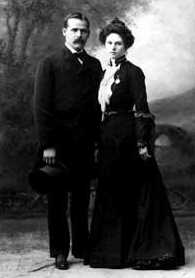 Of all the Wild Bunch members Etta Place is the most mysterious. She is one of the Wild West’s most legendary women. Beautiful and wild she is reported to have been mistress to both Butch Cassidy and Sundance. Eyewitnesses maintain she was the second woman to ride into Robber’s Roost in the winter of 1897. She was allegedly 20 years old at the time, strikingly beautiful, an excellent horsewoman, and outstanding rifle shot, Etta became Sundance’s primary love interest. Of all the Wild Bunch members Etta Place is the most mysterious. She is one of the Wild West’s most legendary women. Beautiful and wild she is reported to have been mistress to both Butch Cassidy and Sundance. Eyewitnesses maintain she was the second woman to ride into Robber’s Roost in the winter of 1897. She was allegedly 20 years old at the time, strikingly beautiful, an excellent horsewoman, and outstanding rifle shot, Etta became Sundance’s primary love interest.
Etta was reportedly a refined, highly educated woman of Eastern birth and rearing. She’s also alleged to have been a prostitute from Texas. Others claim she was a schoolteacher from Denver, Colorado with music as her primary discipline. Even her relationship(s) with Butch and Sundance is a mystery. It’s been said she was Butch’s mistress then Sundance took an interest and she went with him. There are even rumors the three lived as a ménage a’trois. Even her name has been debated as five different women who road with the Wild Bunch used the alias Etta Place.
We do know, Etta traveled to Argentina and Bolivia with Sundance and Butch returning to the United States three times during their time in South America. After returning to the United States in 1908 with Sundance, where he left her in Denver, Etta Place was never heard from again. Many claimed to be her, or claimed to be her son or daughter with Butch, but nothing was ever verified. But once Butch and Sundance were run to ground in South America Etta disappeared, as well.
The six cabins no longer stand at the Hole-in-the-Wall, and time has covered their foundations. But if you’d like a Wild West experience you can stay at the Willow Creek Ranch. The Willow Creek Ranch dates to 1882 when it was founded by Kenneth MacDonald, an immigrant sheep rancher. The area’s small ranchers, such as MacDonald, aided the outlaws because they didn’t want any trouble, and outlaws rustle from large cattle barons and robbed trains with well-filled strong boxes.
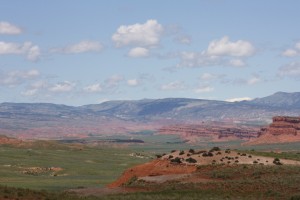 Today, a rugged dirt road leads from ranch headquarters to the former hideout. Guests can walk threw the chunks of foundation remaining. Guests can picnic beneath the old cottonwoods by Buffalo Creek and dream of the days when Butch, Sundance and the gang would seek refuge at the Hole-in-the-Wall. Today, a rugged dirt road leads from ranch headquarters to the former hideout. Guests can walk threw the chunks of foundation remaining. Guests can picnic beneath the old cottonwoods by Buffalo Creek and dream of the days when Butch, Sundance and the gang would seek refuge at the Hole-in-the-Wall.
 Okay folks, we’re gettin’ close so get yer hand off the heel of your gun before ya get us all blown to bits. Smile big and look like ya belong! It’s sure to be a high kickin’ time with this bunch! Okay folks, we’re gettin’ close so get yer hand off the heel of your gun before ya get us all blown to bits. Smile big and look like ya belong! It’s sure to be a high kickin’ time with this bunch!
Howdy, Butch and Sundance! You boys are lookin’ just as fine as frogs hair!
*Pictures from Wyoming Tales and Trails, Willow Creek Ranch website
**Information from Wyoming Tales and Trails, Willow Creek Ranch
Hole-in-the-Wall @ Kirsten Lynn Wild West 2012
Sometimes on the trail ya find a story that lassoes your heart and pulls tight. Characters ya cheer on and embrace like long lost pards and a message that keeps gnawin’ on ya long after the campfire has turned to embers. SAVING HOPE by Margaret Daley was one of those stories for me, and I was plum thrilled when she agreed to let me pass the tale ‘round the fire.
Since Cookie and me get all riled about crimes against our young folk and I’d like to share the message of SAVING HOPE, we decided we’d give one lucky commenter an ebook copy of SAVING HOPE. So, leave a comment and tomorrow at first light I’ll pull a name from the hat.
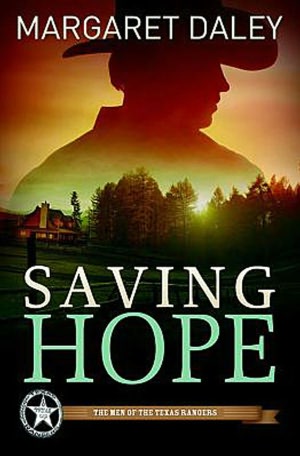 When a teenager goes missing from the Beacon of Hope School, Texas Ranger Wyatt Sheridan and school director Kate Winslow are forced into a dangerous struggle against a human trafficking organization. But the battle brings dire consequences as Wyatt’s daughter is terrorized and Kate is kidnapped. When a teenager goes missing from the Beacon of Hope School, Texas Ranger Wyatt Sheridan and school director Kate Winslow are forced into a dangerous struggle against a human trafficking organization. But the battle brings dire consequences as Wyatt’s daughter is terrorized and Kate is kidnapped.
Now it’s personal, and Wyatt finds both his faith and investigative skills challenged as he fights to discover the mastermind behind the ring before evil destroys everyone he loves.
Today’s feature not only includes a fantastic modern day tough, tender, law-dealing, cowboy, Texas Ranger Wyatt Sheridan, and a brave, intelligent, caring heroine, Kate Winslow, but the message of this book is so dynamic I just had to feature it even though it is contemporary and not historical. Margaret Daley tackles the crime of human trafficking in a powerful story with characters readers come to care deeply about, and a story that pulls you in completely (even to places you don’t want to go).
I would say this book has two heroines, as once you meet Rose Garland you can’t help but love this teenager who has endured the worst humans can dish out, but still finds the will to fight against those who would drag her back to a life of sexual slavery. I found myself verbally cheering Rose on and encouraging her to fight, and wanting to fight for her.
Ranger Wyatt Sheridan is what a hero should be. He’s determined to see justice in rescuing victims of these crimes, and punishment meted out for those dealing in humans. His personal struggles only make him a stronger character especially his relationship with his daughter and keeping his family safe and intact from the horrors he witnesses daily.
Kate Winslow’s driving desires to see the girls in her care overcome their tragic pasts and succeed and prosper…to find hope really inspired me. Her willingness to get in the trenches and do whatever it takes to save as many girls as she can, and her interaction and how she truly gets to know each girl made her a heroine who makes you take stock of what you would do in her situation and how hard would you fight.
But I don’t want to give the impression this is a dark and dreary story you’ll never recover from. What makes SAVING HOPE such a great read is it’s a story of forgiveness not just of forgiving others but ourselves so we can face the future and live the full life God wants for us. It’s a story of faith. Faith in our family, our friends, and in a faithful Heavenly Father. And it’s a story of hope. Of holding onto hope when it seems most out of reach, and of giving hope to others when they can’t reach it on their own.
SAVING HOPE is one of those books when it ends it leaves you with the memories of a great story, but with a challenge of: What can I do?
Please read the message from Margaret Daley about why she wrote SAVING HOPE. It’s so important we become educated about this crime against humanity. And keep your eyes peeled for book two from THE MEN OF THE TEXAS RANGERS series!
*You can read an excerpt here: SAVING HOPE EXCERPT
SAVING HOPE (AMAZON)
SAVING HOPE (BARNES & NOBLE)
Why I Wrote Saving Hope: Human Trafficking
It is estimated that 293,000 American youths are at risk of becoming involved in sex trafficking. We aren’t talking about just 16-18 year olds but younger children, too. The average age is 12-13 years old.
The FBI says this problem is growing in the United States with pimps on social media sites to lure more youths. Most of these teens are runaways or throwaway kids, often children that have been abused or kicked out of their families. Some teens are targeted and kidnapped or their parents sell them to a trafficker. Anyway you look at it, these youths are trapped in a horrific situation with little means of getting out. They become victimized, not just girls but boys, too.
1. We need to recognized the problem.
Human trafficking exist in the United States, not just other parts of the world.
2. We need to see these youths as victims.
These are not criminals to be prosecuted and pass laws to protect our children against this situation and predators.
3. We need to train law enforcement to deal with these youths as victims.
We must give law enforcement the tools and resources to identify the children victimized and ways to connect them to a place that will help them.
4. We need places to give these youths a refuge and a second chance.
We need safe havens–places like Children of the Night have (http://www.childrenof the night.com).
Organizations are beginning to see we need to do something. The Salvation Army is heavily involved in educating the public about the problem. There are organizations that are set up to offer help to children involved in child trafficking–ECPAT and Children of the Night. Also many churches are getting involved. If you suspect a child or situation, please report it to the Human Trafficking Resource Center hotline (open 24/7) at the toll free number 1-888-373-7888.
The above are the reasons I wrote Saving Hope. I taught high school students for twenty-seven years. I never wanted them to become a victim of a human trafficker. I wanted to do something about the problem, to warn them of what can happen if they aren’t careful, but at the same time give the reader an entertaining story that they will remember after they finish the book. I hope people become involved in Kate, Wyatt and Rose’s stories.
Howdy! Good to see y’all back on the trail. Today were headed out of Montana and back to big beautiful Wyoming. In my first blog, I mentioned Sheridan turned this cowgirl’s head and stole my heart. So, we’re gonna visit the area again and then head on down the trail. Let’s get those wagons movin’ we’re burnin’ daylight and we’ve got a ways to go!
The Battle of the Little Big Horn and the subsequent surrender of the Sioux and Northern Cheyenne brought to an end the American Indian conflicts, for all intents and purposes. This opened the door to lands on the eastern slope of the Big Horn mountains to ranchers, cowboys, and homesteaders. John Loucks founded the town of Sheridan in 1882, to serve as a hub for these inhabitants.
When John Loucks arrived, visiting his friend James Works in 1882, he found George Mandel’s post office in a little cabin where the Rock Creek stage line crossed Big Goose Creek. An old cabin built in 1878 by a trapper known as Dutch Henry was nearby, along with a horse barn for the stage-line teams. These buildings became the nucleus for the emerging town.
Works convinced Loucks to stay, and Loucks purchased Mandel’s cabin and claim for $50. Loucks then traveled south to find a justice of the peace so he could be sworn in as postmaster. On his return, Loucks rested as what today is Courthouse Hill. Enthralled by the abundant grass and grazing herds of buffalo and deer, he returned to the cabin and sketched out the town of his dreams on a piece of brown wrapping paper. He named the town for the commander he served under during the Civil War, General Phil Sheridan.
In May 1882, Loucks had an engineer, Jack Dow, from the neighboring town of Big Horn City survey the 40-acre town. Streets were named after several men who had already taken up claims in the area and helped with the survey: Kenneth Burkitt, James Works, George Brundage, Alexander Gould, L.H. Brooks, and W. Scott.
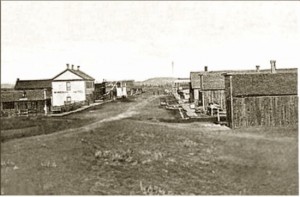 Another of Sheridan’s earliest townsmen, and a man who appears in a few of my stories so a personal favorite, is Henry Held. Held was heading for Yellowstone country when he pulled up his wagon to stay overnight in the brand new town of Sheridan. When Loucks found out the new arrival was a blacksmith, he made Dutch Henry’s cabin available and Held set up shop there. Held filed claim on adjacent land and purchased lots in Sheridan where he built his new blacksmith shop on the northwest corner of Main and Works Streets. Another of Sheridan’s earliest townsmen, and a man who appears in a few of my stories so a personal favorite, is Henry Held. Held was heading for Yellowstone country when he pulled up his wagon to stay overnight in the brand new town of Sheridan. When Loucks found out the new arrival was a blacksmith, he made Dutch Henry’s cabin available and Held set up shop there. Held filed claim on adjacent land and purchased lots in Sheridan where he built his new blacksmith shop on the northwest corner of Main and Works Streets.
Henry Held’s blacksmith shop was the first structure built on the new Main Street in 1882. Held also built the town’s first irrigation ditch, developed one of the earliest subdivisions, and helped build the first electric light plant. He later donated land for the city cemetery.
Of course every Old West town had to have a saloon, and Cow Boy Saloon was Sheridan’s first. It served the areas inhabitants until it became a drugstore after a few years.
John Conrad built his general merchandise store across from the Cow Boy Saloon. Conrad’s store carried everything from knitting needles to threshing machines. Sheridan’s third oldest building still stands at the northeast corner of Main and Loucks Street and has housed the Hospital Pharmacy since the 1980s.
The Grand Central was Sheridan’s first hotel. All of Sheridan’s townspeople, 17 women and 65 men, attended the opening ball on July 3, 1883. The nine-room hotel was replaced by the Keenan Building in 1914.
Other Sheridan firsts include: The first seventeen children to attend school in John Loucks’s cabin, and the first frame school built in 1884. Built at a cost of $1000.00, Loucks contributed the extra $200 for the bell and belfry. Henry Coffeen, who also built a complex of stores known as Coffeen Hall, organized the first fair in Sheridan south of town near Little Goose Creek. Livestock and agriculture shows were a big part of the fair, but horse racing was the most popular event.
Almost half of Sheridan’s 1,000 residents gathered at the depot to welcome the first passenger train at 10:00 a.m. on November 18, 1892. Burlington and Missouri River Railroad executives announced their intent to build a line through Sheridan in 1888, expanding the towns population and connecting Sheridan to the outside world.
Sheridan always had the inside track on its selection as the railroad’s route through northern Wyoming. Several of the Burlington and Missouri Railroad officials from Omaha owned property in the Sheridan area and realized the value of expansion there. With local investors Edward Whitney, Horace Alger, and C.H. Grinnell, they formed the Sheridan Land Company, and built the Sheridan Inn in 1893, right across from the B&M Depot.
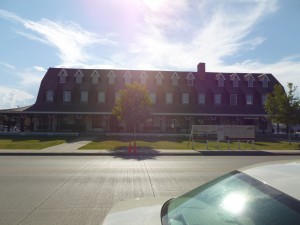 The Inn featured the first running-water bathtubs and electric lights in town, and the first telephone line was connected to a downtown drugstore. Inn guests have included such notables as Ernest Hemingway, Will Rogers, Bob Hope, Robert Taylor, and several presidents. The Inn featured the first running-water bathtubs and electric lights in town, and the first telephone line was connected to a downtown drugstore. Inn guests have included such notables as Ernest Hemingway, Will Rogers, Bob Hope, Robert Taylor, and several presidents.
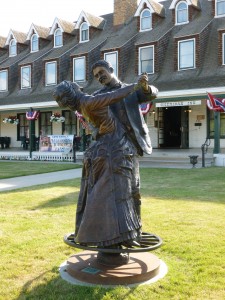 Among its guests was also Buffalo Bill Cody. In 1894, Cody became a Sheridan Land Company partner. Cody auditioned local cowboys for his famous Wild West show from the comfort of the inn’s large porch. Some of the cowboys’ wives were featured in one of the Wild West’s acts. The ladies rode sidesaddle and, with their partners, performed a square dance on horseback. The Inn is still there in Sheridan. You can order a cold one at the same bar where Wild Bill ordered a round for the house, and one of his business partners George Beck originated the popular drink called the Wyoming Slug (a concoction of champagne and whiskey). And a personal note their steak is fabulous and just a warning order one desert to share. Among its guests was also Buffalo Bill Cody. In 1894, Cody became a Sheridan Land Company partner. Cody auditioned local cowboys for his famous Wild West show from the comfort of the inn’s large porch. Some of the cowboys’ wives were featured in one of the Wild West’s acts. The ladies rode sidesaddle and, with their partners, performed a square dance on horseback. The Inn is still there in Sheridan. You can order a cold one at the same bar where Wild Bill ordered a round for the house, and one of his business partners George Beck originated the popular drink called the Wyoming Slug (a concoction of champagne and whiskey). And a personal note their steak is fabulous and just a warning order one desert to share.
Speaking of cowboys, and this is Wyoming so we have to talk about cowboys, Sheridan had its share. You can read about John Kendrick in a previous post, so let’s visit some others.
Some of the largest ranches in Wyoming are in the Sheridan area. Ranchers like W.H. “Doc” Spear, Bill Glasgow, Andy Martinson, Lew Burgess, Nelson Darlington, Guy Wood and Bill Leavitt established large landholdings in the area. One of the largest and earliest ranches in the area was started west of Sheridan by two brothers Matt and Al Patrick, who also had the stage line contract from Rock Creek in southern Wyoming to Custer Station on the Yellowstone River. The PK Ranch is still one of the largest in the area, and portions of it have been set aside as a nature conservancy.
On the heels of ranching came a uniquely western phenomenon, the dude ranch came to 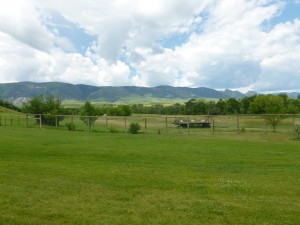 Sheridan. Ranchers discovered that not only friends, but complete strangers were willing to pay for the privilege of riding horses and even helping out with the chores. In 1890, Daniel T. Hilman operated the first dude ranch in Sheridan County near Big Horn when he accepted the first two of a long line of visitors. Sheridan. Ranchers discovered that not only friends, but complete strangers were willing to pay for the privilege of riding horses and even helping out with the chores. In 1890, Daniel T. Hilman operated the first dude ranch in Sheridan County near Big Horn when he accepted the first two of a long line of visitors.
Dude ranches flourished in Sheridan County in the early half of the 19th century. The Dude Rancher’s Association in the West was formed in 1926 to set standards for the industry. The Burlington Railroad helped out by printing special maps of dude ranches in Wyoming and Montana.
The Eaton brothers, Howard, Willis Larimer, and Alden Eaton, launched the nation’s first dude ranch in 1880s at their ranch in North Dakota. The brothers moved their ranch to Wolf, just north of Sheridan, in 1903 making it the second dude ranch in Sheridan County. The Eatons ranch remains one of the better-known dude operations.
When people think of Wyoming, dude ranches can come to mind. Most visitors to Sheridan, myself included, are surprised to learn the sport of polo is alive and well int the American West. Afterall, polo isn’t a typical western sport.
However, the sport of kings found a western home when three Britons introduced the sport in the 1890s. The Moncreiffe brothers bought a ranch just outside Big Horn and named it the Quarter Circle A. Malcolm Moncreiffe and Oliver Henry Wallop and Malcolm’s brother William, partnered to provide 22,550 remounts for the British cavalry engaged in the Boer War. The Moncreiffes became known for the quality of their stock including polo ponies. William Moncreiffe’s registered brand is the second oldest in Wyoming.
It was Malcolm Moncreiffe who was the driving force behind polo in Sheridan County. In 1901, Malcolm developed the first polo field on what would become Polo Ranch southwest of Big Horn, where polo was played until 1984. Since then, the game has been played at the Big Horn Equestrian/Events Center where world-class players and horses appear every summer.
In addition to Big Horn’s Polo Ranch, the game was played at several sites around Sheridan. Cowboys played polo around Saberton Avenue before the hospital was built there and at Sheridan’s original fairgrounds. In 1900, the first match played for a cup took place behind the old Western Hotel near Works and Brooks Streets.
The local Big Horn team, called the Magpies, wore distinctive black and white vests. They traveled to Colorado to compete in matches with teams, including several fielded by the U.S. Army.
William Moncreiffe married in 1908 and remained on the ranch until 1923 when it was sold 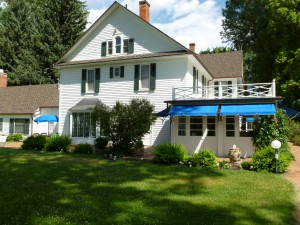 to an Illinois businessman, Bradford Brinton. Brinton used the ranch as a vacation home. Brinton collected many pieces of western art and expanded the ranch. The Bradford Brinton Memorial Museum is opened for visitors and showcases the historic home and vast art collection. to an Illinois businessman, Bradford Brinton. Brinton used the ranch as a vacation home. Brinton collected many pieces of western art and expanded the ranch. The Bradford Brinton Memorial Museum is opened for visitors and showcases the historic home and vast art collection.
Oliver Henry Wallop married Marguerite who was the sister of Amy Moncreiffe (Malcolm Moncreiffe’s wife). Wallop became a United States citizen in 1904 and was elected to the Wyoming legislature in 1908. However, the death of his older brother forced him to assume the earlship and membership in the British House of Lords in 1925. His grandson Malcolm Wallop served for many years as one of Wyoming’s U.S. Senators.
A more familiar site in Western sports is rodeo, and since its beginning Sheridan’s has 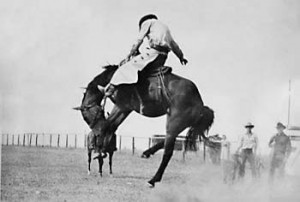 always been one of the best in the West. The Sheridan-WYO rodeo, established in 1931, features all the finest rodeo events. The organizers of the Sheridan-WYO had three goals: keep Sheridan residents home, provide a mid-summer event in Sheridan, and advertise Sheridan to tourists. From its start, the rodeo attracted some of the biggest names in the sport of its day. always been one of the best in the West. The Sheridan-WYO rodeo, established in 1931, features all the finest rodeo events. The organizers of the Sheridan-WYO had three goals: keep Sheridan residents home, provide a mid-summer event in Sheridan, and advertise Sheridan to tourists. From its start, the rodeo attracted some of the biggest names in the sport of its day.
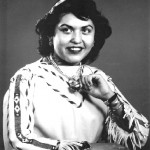 From the beginning, the Sheridan-WYO included a strong American Indian presence. After facing cancellation during World War II, the rodeo came back strong. And in 1952, Lucy Yellowmule, a shy Crow girl, was selected rodeo queen. Aided by reporter Howard Sinclair, Lucy turned her reign into an opportunity to improve American Indian and white relations. She made many public appearances to dispel myths and share American Indian culture. Gradually, new appreciation was gained on both sides. American Indian leaders organized an event called All-American Indian Days, celebrating all tribal cultures and featured a pageant to select Miss Indian America. From the beginning, the Sheridan-WYO included a strong American Indian presence. After facing cancellation during World War II, the rodeo came back strong. And in 1952, Lucy Yellowmule, a shy Crow girl, was selected rodeo queen. Aided by reporter Howard Sinclair, Lucy turned her reign into an opportunity to improve American Indian and white relations. She made many public appearances to dispel myths and share American Indian culture. Gradually, new appreciation was gained on both sides. American Indian leaders organized an event called All-American Indian Days, celebrating all tribal cultures and featured a pageant to select Miss Indian America.
Like all Western towns Sheridan has faced fire, flood, boom times and bust times, but year after year the people of Sheridan have struggled, straggled, rebuilt, built more, persevered and preserved their history. It’s no wonder Sheridan is continually named one of if not the number one Western town in America. But folks we have a little more traveling to do before nightfall. I know, I know it rips my heart out to leave Sheridan, too, but these next stops will be worth the trip. We’re heading into the Big Horn National Forest.
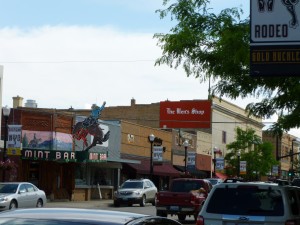 Before we head out let’s make one last stop at the Mint Bar, established in 1907, still in business on North Main Street. It was at the Mint, Theodore Roosevelt noted that cowboys “when drunk on the villainous whiskey” would “cut mad antics such as riding their horses into the saloons.” And indeed, the custom continues today. The Mint Bar continued to operate through prohibition, although quietly. Upon the repeal of prohibition it officially reopened. Sheridan even had its own brewery, the Sheridan Brewery, maker of Sheridan Export and Sheridan Pale, in business from 1885-1954. The Mint makes an appearance in one of my stories, and yes a cowboy rides his horse into the saloon. Before we head out let’s make one last stop at the Mint Bar, established in 1907, still in business on North Main Street. It was at the Mint, Theodore Roosevelt noted that cowboys “when drunk on the villainous whiskey” would “cut mad antics such as riding their horses into the saloons.” And indeed, the custom continues today. The Mint Bar continued to operate through prohibition, although quietly. Upon the repeal of prohibition it officially reopened. Sheridan even had its own brewery, the Sheridan Brewery, maker of Sheridan Export and Sheridan Pale, in business from 1885-1954. The Mint makes an appearance in one of my stories, and yes a cowboy rides his horse into the saloon.
The Big Horn National Forest is eighty miles long and thirty miles wide. The Forest covers 1,115,073 acres, and extend from the Great Basin area of Wyoming northward to Montana. Elevations range from 5,500 feet to 13,175 feet (Cloud Peak).
Hold onto your mules folks we’re headin’ up the Dayton-Kane Highway! God bless your hearts! Make sure your supplies are tied down tight and iffin ya don’t like heights I’d hunker in the back of the wagon.
The Dayton-Kane was named for two small communities. Dayton is still there, but Kane was destroyed when the Bureau of Reclamation condemned the land and bought the community in 1965 when the Yellowtail Dam neared completion and the Bighorn Lake would flood Kane.
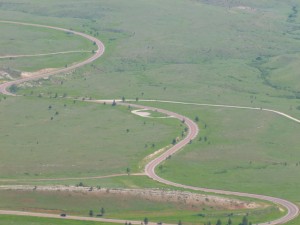
All that being said let’s head up the road and by up I mean waaay-up. First stop, Sand 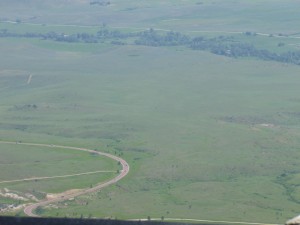 Turn. I’ll just stand back and let you take all the pictures you’d like. It’s an amazing site looking over the road you just traveled, all the twists and turns. Many visitors hang glide from Sand Turn and best of luck to them, I’m getting back in the wagon. Turn. I’ll just stand back and let you take all the pictures you’d like. It’s an amazing site looking over the road you just traveled, all the twists and turns. Many visitors hang glide from Sand Turn and best of luck to them, I’m getting back in the wagon.
As we travel take time to check out all the gorgeous wildflowers at their peak in the Big Horns in late June and early July. It can take a good bit of time to get down the mountains when you stop every few feet for a photo opportunity (this is from personal experience, but I’d do it all again).
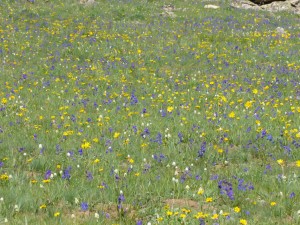
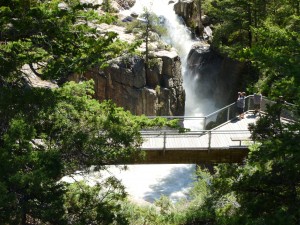 Next stop are the Shell Falls. These are spectacular and make sure you walk the paths to get the falls from all angles and find other falls cascading down the mountains. Next stop are the Shell Falls. These are spectacular and make sure you walk the paths to get the falls from all angles and find other falls cascading down the mountains.
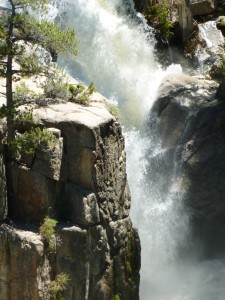
Another interesting spot is the old Beef Trail. I don’t mind taking pictures, but Cookie would demand a huge raise if this trail boss took the herd up that narrow path and this trail boss would demand a huge sedative.
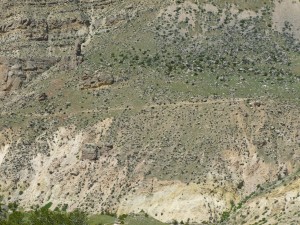 We’ll just ease on down into the basin leaving the majesty of these mountains. Hope y’all enjoyed just this brief glimpse of what Sheridan and the surrounding area offers. But please folks if ya only choose one place to visit from all these posts make Sheridan and the Big Horns it! We’ll just ease on down into the basin leaving the majesty of these mountains. Hope y’all enjoyed just this brief glimpse of what Sheridan and the surrounding area offers. But please folks if ya only choose one place to visit from all these posts make Sheridan and the Big Horns it!
Now if ya’ll will excuse Cookie and me we have to go shed a few tears around the campfire. We always get a might choked up when we visit this piece of God’s country. Below are some links to places to visit that should keep ya busy for a time and give ol Cookie some time to compose hisself for the next leg of our journey!
KING’S SADDLERY AND DON KING MUSEUM
SHERIDAN COUNTY MUSEUM
BRADFORD BRINTON MEMORIAL
SHERIDAN, WYOMING
*All colored photographs are property of Kirsten Lynn
*Black and white photographs from “Tales and Trails Wyoming”
Sources:
Sheridan County Museum (Information from placards around Museum)
Blair, Pat, Prater, Dana and the Sheridan County Museum. Images of America: Sheridan. Arcadia Publishing, 2008.
Wagons West Sheridan @ Kirsten Lynn 2012
The boys and I are fairly burstin’ at the seams about today’s featured author Peggy L. Henderson and her Yellowstone Romance Series! Why Cookie almost fell in the dutch oven of beans at a series of stories takin’ place in our old stompin’ grounds!
And yippee ki yay, we’re dancin’ a jig cause y’all are winners today! Today and tomorrow (April 18 and April 19 on Amazon) you can upload YELLOWSTONE HEART SONG for FREE!! We’re shootin’ are six guns in the air!! And don’t y’all forget National Park Week, April 21-29!!
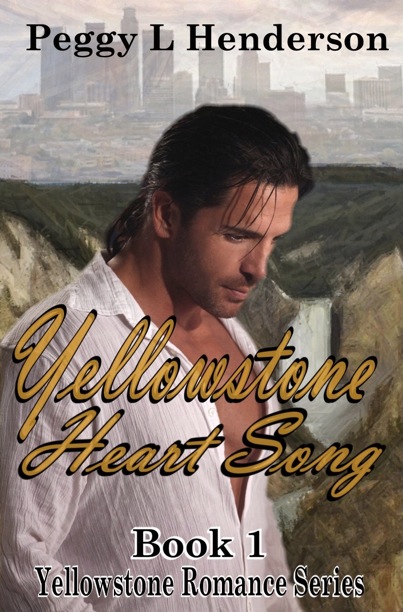
Nurse and avid backpacker Aimee Donovan is offered the opportunity of a lifetime. She encounters a patient who tells her he can send her two hundred years into the past to spend three months in the rugged Yellowstone wilderness at the dawn of the mountain man era. The only requirement: she cannot tell anyone that she’s from the future.
How did a white woman suddenly appear in the remote Rocky Mountain wilderness? Trapper Daniel Osborne’s first instinct is to protect this mysterious and unconventional woman from the harsh realities of his mountains. While he fights his growing attraction to her, he is left frustrated by her lies and secrecy.
Daniel shows Aimee a side of Yellowstone she’s never experienced. She is torn between her feelings for him, and exposing a secret that will destroy everything he holds as truth. As her three months come to an end, she is faced with a dilemma: return to her own time, or stay with the man who opened her eyes to a whole new world. When the decision is made for her, both their lives will be changed forever.
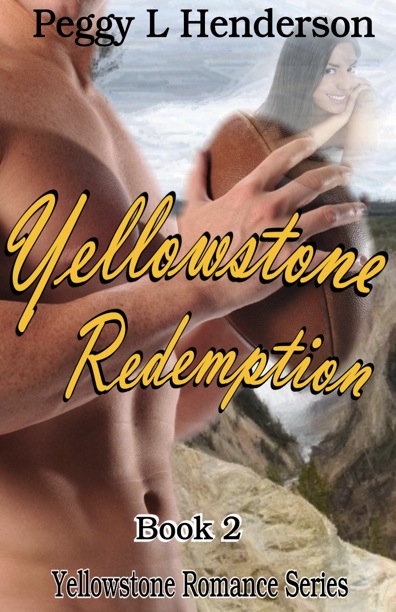
City boy Chase Russell is on the fast track to self-destruction. A star athlete, he gets into trouble with drugs and alcohol. Fulfilling a community service sentence in Yellowstone National Park is the last thing he wants to do. After a night of drinking in the park, he wakes up to find his new friends gone, and everything around him has changed.
Sarah Osborne grew up in the rugged Yellowstone wilderness. She can hunt and track right alongside the most experienced men. When some Indians drop a near-dead man off on her doorstep, she doesn’t know what to think. He’s convinced he’s from the future, and wants to find a way home.
Chase has no idea how he ended up time traveling to the past. He doesn’t know the first thing about surviving without modern conveniences. Finding your own food means a quick trip to the nearest fast food joint, not hunting and foraging for it. Time and again, his will is tested to stay alive in this untamed land. Is his growing love for a brave woman who shows him what it truly means to be a man strong enough to keep him in the past, or is he still determined to return to the ease and comforts of the future?
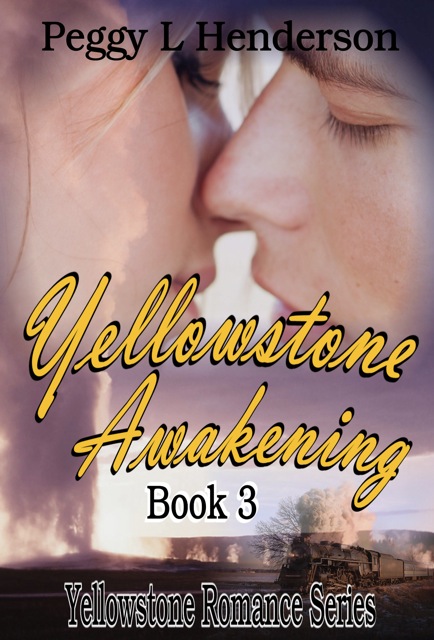
A tender, heartfelt love story . . .
A man willing to risk everything, including his life and all he’s worked for, to free the woman he loves from an impossible situation.
Kyle Russell has worked with prominent men, led scouting expeditions through the Yellowstone country, and irritated more than a few Indian braves, but he will never duplicate his father’s legendary accomplishments. Captured by a group of Crow warriors, his plans of escape are derailed when a lone white woman is brought into camp.
Kate Ellen Devereaux is on the run. Her guardian is dead, and she is lost in the Yellowstone wilderness. Found by an Indian war party, she is brought into their camp and thrown at the feet of a white captive. If he has plans of escape, she won’t be left behind.
Kyle’s father may be a legend in the territory, but he never had to deal with an eastern lady full of secrets, a woman who disrupts Kyle’s plans to see the Yellowstone area turned into a national park. Convincing her that they are destined to be together may be a greater challenge than gaining support for the park movement. Kate can’t afford to show interest in any man, regardless of her growing attraction to her backwoods rescuer. Will her ultimate reason for rejecting him spell doom for their growing love, and the national park idea, or can Kyle find a way to rescue both?
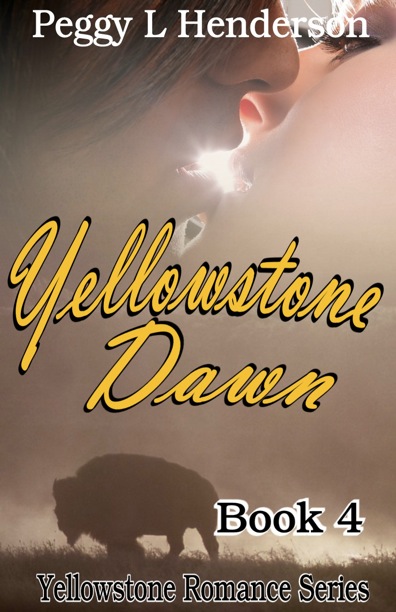
Danica Jensen dreams of a man she knows she can never have. After one brief encounter five years ago, her heart was lost to him forever, and she’s never given up hope of seeing him again. Raised by a bitter father, she’s learned to be strong and resourceful on her own. When a pleasure trip to the newly created Yellowstone National Park turns into a battle for survival, her inner strength is tested like never before.
A woman like Danica doesn’t interest Josh Osborne. He’d be crazy to get involved with a bossy, strong-willed white woman. His mixed heritage has always made people weary of him. He prefers to be on his own, and his role as protector of the national park’s game allows for no attachments.
Danica’s dream of ever winning Josh’s heart shatters after a cruel twist of fate changes her life forever. Suddenly forced together, they must confront their deepest secrets. Josh can’t deny his growing respect and admiration for this brave woman, but will the bond they’ve forged be powerful enough to turn his feelings into love? When an unforeseen danger threatens their lives, Josh must protect more than the wild inhabitants of the park.
KIRSTEN’S THOUGHTS: This is such a fresh and exciting series. I only recently discovered Peggy Henderson and her fabulous series, so I have only read YELLOWSTONE HEART SONG, but I am hooked!! Of course, she had this Wyoming girl at Yellowstone. But really, I found the time period, early 1800s during an era when only a few trappers and adventurers ever laid eyes on this wonderland extremely original. The time travel aspect is wonderful and Aimee’s reaction was realistic in thinking she could handle everything since she had been to the park many times in the 21st Century, only to find early 19th Century Yellowstone is a someplace altogether different. Daniel is a wonderful hero who learns while he might know about surviving in the wilderness; he’s clueless when it comes to the stubborn woman who dropped into his life. Their journey of learning about each other and how to survive the love they develop is as tough as the land and tender as a love song. I don’t want to say too much because Daniel and Aimee’s story is such a joy to discover on your own.
The amount of information regarding the area is amazing, and you’ll find yourself learning even as you’re entertained. It’s easy to tell this series is written by an author who loves the area and knows what she’s talking about.
When I first started this story, I thought “This is a good story, I like this.” Then BAM!! It reeled me in like a bass on a hook.
So move swiftly and don’t spare the horses to take advantage of the freebie offer on Amazon of YELLOWSTONE HEART SONG. And you might-as-well get the rest of the series, cause once you read Daniel and Aimee’s you’ll be dangling from the line with me for more.
MESSAGE FROM PEGGY HENDERSON:
Yellowstone Heart Song was born on a lone stretch of Interstate 5, heading home from a trip to Yellowstone National Park in 2009. Driving through the Utah desert every year on a thousand mile (one way) road trip to the park, the mind has a lot of time to wander. Although the published story has some changes in it, the original concept remains the same as it took shape in my mind. I’ve never thought about writing a book of any sort, but I had been reading romance, especially western and early American historical, for many years, so this story came as a complete surprise to me. I didn’t think much of it over the months, but it always stuck with me in the back of my mind.
The following year, on another trip to Wonderland, I took greater notice of all the places in the park that were part of that story in my head. The day after we got home, I sat down to write. It just wouldn’t let me go. I told no one what I was doing. The thought of letting anyone else see what I wrote was laughable. A year later, I had a finished story. Now what? I checked around the internet. I wanted someone to read it, just to let me know what they thought, but never did I have publishing in mind. I found some RWA contests, and entered one. My scores were decent that first time around to my surprise, and I tweaked the story based on each judge’s comments. I entered another contest, and finaled! How shocking was that! My harshest judge said, “find a critique partner.” So I searched the internet again. And I struck gold when Carol Spradling answered my query. She tore through my manuscript with a loaded red pen and fine tooth comb. Months later, she asked me when I would pursue publishing. What?!?! I basically ignored her. She wanted to know what I would write next. Huh??? Okay, I thought. I love Yellowstone, I can’t think of anything else to write, and I loved the interaction with Carol, so why not write a sequel? That’s how Yellowstone Redemption came to be. Carol hated my new hero as much as she loved Daniel in the first book. I told her to trust me, Chase would end up just fine. After I completely surprised her with the ending in that book, I was gung ho to write another. I knew right away I could never duplicate a story like the one in Book 2, and decided to write a hero who was just a nice guy, trying to solve an impossible problem for his leading lady. Yellowstone Awakening was a few chapters from completion before Carol put the brakes on me, and told me I need to get something published. Her experiences with her publisher scared me away from that idea, until my husband suggested I self-publish. So, that’s what I ended up pursuing, and I published Yellowstone Heart Song on January 2nd, 2012. The reader response has been overwhelming, to say the least.
By now, it became obvious that this was turning into a series, and I wrote a couple of characters into Book 3, who would be my main characters for the fourth book, Yellowstone Dawn, which releases today! The series has evolved from one stand alone book, to me taking factual events from Yellowstone’s history, and weaving them into my stories. Yellowstone Redemption contains a scene that was inspired by John Colter’s legendary escape from the Blackfoot Indians. Yellowstone Awakening is a fictional account (with true facts sprinkled in) of the creation of the nation’s first national park, and Yellowstone Dawn deals with some of the problems the park encountered in its infancy. The final book I am writing in the series, Yellowstone Deception, will deal with a more current issue the park has faced.
I’ve enjoyed my journey as a writer so far, and hope to bring the old west, the mountain men, and the Rocky Mountains to life in future books I plan to write.
Folks we’re likely to give those mules whiplash goin’ north than south only to whip back north, but I’ll try to keep us on a straighter trail the next few weeks.
Anywho, this week we’re turnin’ the wagons to Montana Territory and THE BATTLE OF THE LITTLE BIG HORN!
But we can’t go rushin’ into things and right into the middle of the battle (we all know how 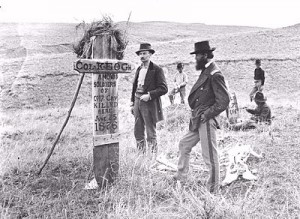 that kind of rash action faired for Custer) Don’t get your petticoats in a bunch, we’ll get there, but first let’s take some side trails to northern Wyoming and South Dakota. that kind of rash action faired for Custer) Don’t get your petticoats in a bunch, we’ll get there, but first let’s take some side trails to northern Wyoming and South Dakota.
The Bozeman Road enraged the Sioux and Cheyenne from it’s opening in 1863-64, because it crossed the Powder, Tongue, and the Big Horn rivers, lands they and their Crow enemies claimed as prime hunting grounds. Teton Sioux, Cheyenne and Northern Arapaho warriors allied to defend this territory, first in an attack at Platte Bridge Station, July 1865, and then against the troops brought against them. Hostilities escalated when Colonel Henry Carrington and his infantry headed for the Powder River, leading Red Cloud (the most powerful of the Sioux Chiefs) to lead the majority of Indian leaders to walk away from peace negotiations at Fort Laramie to return and defend their lands.
Carrington and his men established three forts in the area, Fort Reno, Fort Phil Kearny, and Fort C.F. Smith. Carrington’s troops quickly found themselves in an impossible situation with low morale and vastly outnumbered by the Indians. Red Cloud’s warriors closed in and placed the forts under siege with Fort Phil Kearny facing the worst of it.
In December 1866, a brash and reckless officer Captain William J. Fetterman took eighty-one men out of the fort to protect a wagon train and impetuously followed warriors led by a young Sioux war chief, Crazy Horse. Within forty minutes Fetterman and his men where dead. The Fetterman massacre shocked the nation and more troops were sent to the area to build a stronger fort, Fort Fetterman. Violence escalated and by 1867 the government realized it must vastly increase troops on the Bozeman Road or abandon it.
In the Fort Laramie Treaty of 1868, the Sioux seemingly got what they wanted. Red Cloud refused to discuss terms until the soldiers left the hated forts. The Bozeman Road was closed, the forts closed, with the promise of no new posts in that area. In line with the new policy of “concentration” the commissioners persuaded the chiefs to accept a reservation centering on the Black Hills and consisting mainly of today’s South Dakota west of the Missouri River. It must be noted that the Powder, Tongue and Big Horn areas, where Red Cloud had just won his war, were not part of the reservation. This area became unceded Indian lands, closed to general white entry, available for seasonal hunting, but not permanent occupation by the Indians.
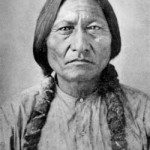 Sitting Bull This treaty, like others before it, was only a temporary peace. Red Cloud and most of the older chiefs went on the reservation, but many younger Sioux leaders, like the Hunkpapa chief, Sitting Bull and the Oglala Crazy Horse, refused to accept the decision. These “nontreaty” Indians kept their bands in the unceded lands. Treaty commissioners expected these bands to be forced to the reservation when buffalo hunting declined. But these Sioux adamantly refused to settle on reservations and ventured farther north into the Yellowstone territory to hunt, making white settlers uneasy.
While things in the Yellowstone remained static for the most part, things in the Black Hills were building steam like an out of control locomotive headed toward a cliff. Rumors of gold spurred white men into the sacred Black Hills, lands clearly defined within the 1868 reservation. Men hungry for gold and good agricultural lands poured into this area.
In 1874, an officer hungry for glory, Colonel George A. Custer threw coal into the engine as 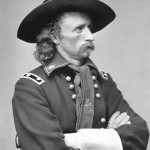 he led an “expedition” into the lands and sent back reports of a land heavy with gold and ripe for agriculture. And although Indians killed some and the army half-heartedly threw out others, still settlers came by the thousands. The 1875 gold boom made a travesty of the 1868 treaty and brought to a boil the situation with the Sioux. As more and more whites flooded the area the Indians left the corrupt agencies and headed west to join the nontreaty bands. he led an “expedition” into the lands and sent back reports of a land heavy with gold and ripe for agriculture. And although Indians killed some and the army half-heartedly threw out others, still settlers came by the thousands. The 1875 gold boom made a travesty of the 1868 treaty and brought to a boil the situation with the Sioux. As more and more whites flooded the area the Indians left the corrupt agencies and headed west to join the nontreaty bands.
President Grant and policy makers far removed from the lands further complicated the issues. While passively allowing settlers into the Black Hills region, military force would be used to drive the Sioux and Cheyenne out of the unceded lands and back to the reservations.
Early December 1875, the Indian Bureau sent messengers to the bands in southeastern Montana and northeastern Wyoming, ordering them to return to the reservation by the end of January 1876. First, if you look at the timeline the order did not give the tribes enough time to comply, but it did not matter as the Indians had decided to stand and fight in any case. The United States Army officially called these bands “hostiles.”
The army eagerly made its first move against these hostiles in March 1876. General George Crook, who proved himself against the Apache in Arizona led 900 men north from Fort Fetterman, Wyoming. Facing subzero weather the first confrontation “Battle of Powder River” accomplished almost nothing. Even though a large band of Sioux was captured the army was unable to hold or destroy the camp. Crook returned to Fort Fetterman.
From his Chicago headquarters, General Phil Sheridan, developed a spring-summer three pronged campaign to corral the Sioux and Cheyenne. Three large armies would be sent into the unceded lands with the hopes at least one would engage the hostiles and defeat them. The “Montana Column” began moving down the Yellowstone in April 1876, with 450 infantry from Fort Shaw and Fort Ellis. Their commander was Colonel John Gibbon and their assignment was to block any Indian movement north or west of the Yellowstone. The “Dakota Column” left Fort Abraham Lincoln near Bismarck in mid-May under the command of General Alfred Terry. They moved across the Dakota plains and up the Yellowstone Valley. Among Terry’s column was the 700 man Seventh Cavalry under Colonel George A. Custer.
Custer was already a national hero for actions during the Civil War and as a dashing Indian Fighter. Originally, he was supposed to command the entire Dakota Column, but was removed from command when he testified against President Grant’s brother regarding the corruption of the Indian Services. At the last minute he was allowed to go along with the column and command the Seventh. Historians speculate Custer may have acted as he later did at Little Big Horn in an attempt to recover his glorious reputation he believed Grant tarnished.
While the Montana and Dakota columns moved toward a rendezvous on the lower Yellowstone, General Crook again led the army north from Fort Fetterman. Crook, Gibbon and Terry had only a general idea where the Indians where and how many there might be. Throughout the spring of 1876, bands of Sioux and Northern Cheyenne fled the reservation and joined the hostile camps near the Rosebud and Little Big Horn rivers. By June, their villages may have housed as many as 15,000 people, including three to four thousand warriors.
The three advancing columns were forced to act somewhat independently since communications were slow and unreliable. Crook encountered the Indians first. On June 17, his men paused on Rosebud Creek, a large Sioux-Cheyenne force under Crazy Horse, attacked them. It was a helter-skelter attack and counterattack ending when the Indians withdrew. Crook and his men withdrew, as well, back to Goose Creek. Crazy Horse moved to join their allies. This battle effectively removed Crook’s column from the campaign.
Terry and Gibbon converged on the Yellowstone. They had no idea about Crook’s location. They chose a sensible strategy of attempting to entrap the Indians from both the north and south. They would send Custer’s swift Seventh Cavalry on a sweep southward up the Rosebud and then across and down the Little Big Horn. Meanwhile, they would move the slower infantry southward up the Big Horn and then up its Little Big Horn tributary. Both armies should reach the Indian village on June 26, 1876. Terry gave Custer considerable discretion if the Indians seemed likely to escape.
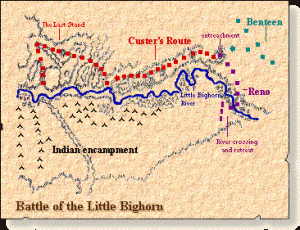 June 22, Custer rode up the Rosebud. On June 24, he made his first controversial decision. Instead of following Terry’s order, he pursued and Indian trail westward before reaching the upper Rosebud. Driving his men to exhaustion on a night march, Custer reached the divide between the two streams, at dawn June 25, and his scouts reported smoke of an enormous encampment. Whether to gain all glory, or to hit the Indians before they could scatter, or both, Custer decided not to wait for Terry and the 26th rendezvous date. He failed to acknowledge the immensity of the Indian gathering, even though his terrified scouts warned him. The Seventh, in his vain opinion, could whip any number. June 22, Custer rode up the Rosebud. On June 24, he made his first controversial decision. Instead of following Terry’s order, he pursued and Indian trail westward before reaching the upper Rosebud. Driving his men to exhaustion on a night march, Custer reached the divide between the two streams, at dawn June 25, and his scouts reported smoke of an enormous encampment. Whether to gain all glory, or to hit the Indians before they could scatter, or both, Custer decided not to wait for Terry and the 26th rendezvous date. He failed to acknowledge the immensity of the Indian gathering, even though his terrified scouts warned him. The Seventh, in his vain opinion, could whip any number.
Mid-day, Custer’s troops advanced down Reno Creek, out of sight from the Indian camp, the stream the Indians called the “Greasy Grass.” Custer divided his command into three units. Three troops under Captain Frederick Benteen to scout the hills west of the village, hoping Benteen could contain an Indian retreat. Major Marcus Reno, was ordered to cross the Little Big Horn with three more troops, and strike the camp at its southern end. Custer would retain the remaining five troops and skirt the bluffs to the right of the village and attack the center.
When Reno hit the near end of the enormous village, the Indians did not panic and rallied under Chief Gall and rushed their attackers. Reno tried and failed to form a defensive skirmish line. He led his men in a disorganized and bloody retreat back across the river and dug in on the bluffs there. Benteen’s returning force soon joined what was left of Reno’s, with Benteen taking over for the distraught Reno.
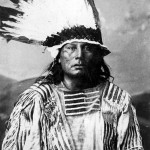 Chief Gall Unaware of these developments, Custer emerged from the bluffs to the east of the village and attempted to cross the river and attack it. But Gall’s warriors, having left Reno’s force, moved across the stream and attacked Custer instead. The colonel retreated up the ridges, but it was too late. More warriors joined Gall, and Crazy Horse led another attack flanking from the north. The Indians overwhelmed Custer’s skirmish lines, and within a half-hour wiped out his command. While they celebrated a great victory, the Indians kept Reno and Benteen under siege until evening the next day. Aware that more soldiers were coming they dispersed. Terry and Gibbon arrived at the battlefield on June 27, 1876. They buried more than two hundred and sixty dead and prepared Reno’s and Benteen’s wounded for removal to the steamboat Far West.
News of the “Last Stand” blazed across newspapers throughout the country in early July 1876. Highly inaccurate accounts of “the massacre” disrupted Fourth of July celebrations of the nation’s centennial, and sent Americans poring over maps of Montana Territory. Custer became the legend and hero he always desired being, and generations of schoolchildren learned of his daring actions, but never of his impetuous recklessness. And every western saloon, it appeared, displayed a romantic Anheuser-Busch painting of the battle. Custer’s wife, Libby, was the greatest proponent of spreading his legend, and it is believed it was in her honor that those who knew best of his actions on that day, kept their mouths closed until after her death.
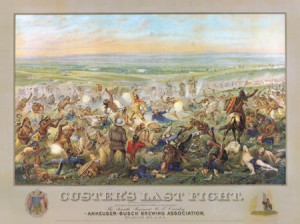 The Battle of the Little Big Horn was in no way decisive. The Indians won a significant victory, but this victory only postponed their ultimate and tragic defeat. More troops descended on the plains at the call for unconditional surrender. The Battle of the Little Big Horn was in no way decisive. The Indians won a significant victory, but this victory only postponed their ultimate and tragic defeat. More troops descended on the plains at the call for unconditional surrender.
Brave chiefs and warriors like Sitting Bull and Crazy Horse continued to resist. But in 1877, starving and demoralized Sioux and Northern Cheyenne bands surrendered. Even the great Crazy Horse gave up in early May. By autumn1877, the conquest of the proud Sioux and Northern Cheyennes was complete. Their brave “stand” against Custer all but forgotten and diminished by the Custer propaganda until cooler heads removed from the time and prejudice could provide a complete picture to the events in June 1876.
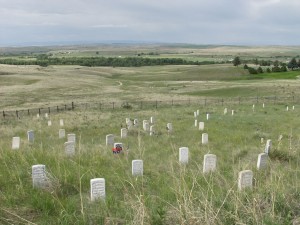 So take your young’uns on up to Montana where every June reenactors bring history to life. This year y’all can catch a full color reenactment on June 22, 23, or 24th. Iffin’ ya want to join the action contact www.custerslaststand.org and ride into battle with Sitting Bull and Crazy Horse, or with George A. Custer’s Seventh Cavalry. So take your young’uns on up to Montana where every June reenactors bring history to life. This year y’all can catch a full color reenactment on June 22, 23, or 24th. Iffin’ ya want to join the action contact www.custerslaststand.org and ride into battle with Sitting Bull and Crazy Horse, or with George A. Custer’s Seventh Cavalry.
The other forts and battlefields mentioned in this post can be visited, as well. In some cases, the buildings are gone, but there are still markers and signs you can follow. And don’t forget to visit The Custer Battlefield Museum in Garryowen, MT.
Toss the young’uns in the wagon and continue their learnin’. Heck, they won’t even know this is all that yuck from their ol history books, and they’ll learn somethin’ before they realize what happened. And ya know y’all just might learn somethin’, too.
See ya on the trail, and watch how ya drive those mules! Last time ya almost ran clear into Cookie’s grub wagon, he liked to ‘ave turned the air blue.
**Crazy Horse is not pictured in this post as I could only find pictures thought to be the Sioux warrior
Source:
Malone, Michael P., Lang, William, Roeder, Richard. Montana: A History of Two Centuries. University of Washington Press. Seattle. 1976.
My own essay written in 1995 while attending Montana State University-Billings, and plaques on trails of the various battle listed from my trips to these locations.
We have us a fun time over at the Wild West, but there are times when fiddles need to be stored, yee-haws need to be hushed and we need to veer off the trail and rope in on an issue. One thing always valued in the Old West was children and here at Kirsten Lynn’s Wild West we keep that tradition alive. Our children should be treasured and protected. But unfortunately for thousands of children they are used as pawns by one parent in a vindictive “punishment” against the other. They are kidnapped by a parent they trust, brainwashed against another parent they love and scarred by one of the two people who should be protecting them from all harm.
So today, with her permission, I am re-posting Angeline De Luca’s thoughtful, heartfelt and inspiring review of CHASING THE CYCLONE by Peter Thomas Senese a man who not only writes about this devastating tempest, but lived in its terrifying path and snatched his son from the dark clouds before he was lost forever in the violent storm.
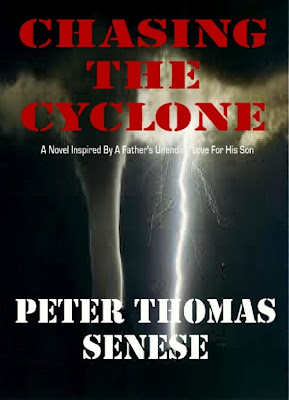
Blurb: Paul Francesco is an independent, successful single man in his late thirties who has everything in the world going for him: financial stability with the real possibility of obtaining significant wealth, a dedicated and loyal group of family and friends, and a challenging, exciting, and rewarding career. Except Paul has one problem: he lives with a deep, dark secret that torments him: he is a ghost living in purgatory despite his relative success.
Unknown to Paul, there is an evil plan to extort his hard-earned assets from him and in the process deny him the one thing that is more important to him than anything else in the world: to be an active part of his son Alex’s life. Unfortunately, his innocent and trusting seven-year old son is at the center of this vicious and diabolical plot directed at him.
When things go from bad to worse to unbelievably insane – when judges choose not to uphold the laws of their nations, when law enforcement turns a blind eye, and when one government after another’s hands are tied due to bureaucratic issues of jurisdiction or non-participation of the international treaty on child abduction, the only thing that could prevent Alex from becoming another sad and sorry statistic on a report that nobody wants to read or think about is his father’s vow to never abandon him no matter what. As a result, Paul is forced to become a hunter, chasing the predators who have taken his son to the other side of the world. With the situation becoming more and more desperate, he is forced to find other resources to help him.
As the hunt moves across international borders, taking Francesco to the other side of the world, he gathers together an extraordinary group of individuals, each with their own powerful stories, to help him. The story moves from The United States and Canada, to the island nations of Oceania, and culminates in the horrifying black-markets of Asia.
Chasing The Cyclone by Peter Thomas Senese is written as a first-hand account of the growing epidemic that is international parental child abduction, and the extreme difficulties all parents whose child has been abducted must face in order to protect the welfare of their victimized child or children. This story makes clear what needs to be done both here in The United States and throughout the world in order to protect children from being abducted and taken across international borders.
Angeline’s Thoughts: If I had to use one word to describe Chasing the Cyclone by Peter Thomas Senese it would be phenomenal. As in remarkable. Extraordinary. I have read many books over the years, for enjoyment, for education, because I had to, because I wanted to. I cannot think of any other book that comes close to making me feel as I did when I read this book. I believe these feelings will stick with me forever. This story, inspired by horrific events, is about the love between a father and a son. And that love is beautiful.
Like the blurb states, Chasing the Cyclone takes us on Paul’s journey discovering his ex-wife’s deceptions at the expense of their son, Alex. Kidnapping him with help from others; she relocates to New Zealand. The failure of the court system is unreal, particularly before she leaves Canada. Alex is a US Citizen, but since he was abducted from Canadian soil, the US could do nothing to help. Those helping her try to extort Paul; did not have Alex’ welfare in mind. They were greedy. And evil. Paul does everything he can to rescue his child. With the help of several amazing people, he does just that.
We not only see the roller coaster ride Paul is on, we feel it. Mr. Senese writes this story from his heart. It is a subject he knows all too well after all. The ups. The downs. And my goodness there is a lot of downs. My heart broke. I was spitting mad. I was so frustrated many times. I know what I felt, I can’t imagine what Paul felt. Then he would see his son, the clouds would lift and the love between them bounced off the page; straight into my heart.
About a third of the way through the book, Paul is wondering how he will go about forgiving her “because that’s what it’s going to take for Alex to become whole again.” I had to stop reading and think about this. I admit that forgiveness was the last thing on my mind. I had zero compassion towards the woman. Then I was reminded that she is still the mother of his son. Alex needs both his father and mother. Although she was keeping him away from Paul, she does love Alex and Alex loves her.
Paul was absolutely right. He would need to forgive her eventually, for Alex and his sake. He also knew it wouldn’t be easy. Forgiveness, an admirable quality to have and Paul has it. More proof of what a good man Paul is. A good man and full of grace.
Paul has amazing friends to help him through. They stood by him, traveled with him and supported him without question. In another life examining moment, I was thankful because I, too, have these kinds of friends (minus any special ops type training, of course). I cherish each one of those friendships. The basis of the book is tragic, but there is a lot of love shown in it too.
I could not put this book down. Inspired by the realities a parent targeted for abduction faces, I knew before I read it that it would be emotional. I, also, knew in my heart that this story was meant for me. Not because I am going through anything similar or that I know of anyone else who is, but because I could be a voice for thousands upon thousands of children abducted by their own parent(s). Our society is not aware of the enormity of international parental abduction. It’s huge. We need to educate ourselves.
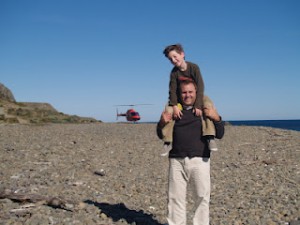 Although Mr. Senese is reunited with his son, his work continues as was evidenced by a large number of sworn testimonials by many thankful parents who Mr. Senese has directly helped in either reuniting with their own child or preventing their child from being internationally abducted. Establishing the I CARE Foundation and being closely involved in the rescue attempts of abducted children is but one of the many impactful acts of Mr. Senese. Clearly, ‘involved’ for Mr. Senese means financially, emotionally, legally, and investigative support. Hundreds of thousands of children are at risk. With the work of Peter and the ICARE Foundation, not only have many children been rescued, but important legislation has been presented and the courts are being educated. Mr. Senese is a lifeline for other Chasing Parents. His selflessness is inspiring. He is hope. Although Mr. Senese is reunited with his son, his work continues as was evidenced by a large number of sworn testimonials by many thankful parents who Mr. Senese has directly helped in either reuniting with their own child or preventing their child from being internationally abducted. Establishing the I CARE Foundation and being closely involved in the rescue attempts of abducted children is but one of the many impactful acts of Mr. Senese. Clearly, ‘involved’ for Mr. Senese means financially, emotionally, legally, and investigative support. Hundreds of thousands of children are at risk. With the work of Peter and the ICARE Foundation, not only have many children been rescued, but important legislation has been presented and the courts are being educated. Mr. Senese is a lifeline for other Chasing Parents. His selflessness is inspiring. He is hope.
I have added Mr. Senese to my bucket list of people I’d love to meet in person in my lifetime. It’s been a pleasure visiting with Mr. Senese over the last few weeks. He is sincere and he is doing great things for other Chasing Parents. Please visit his website to learn more about international parental abduction and to learn where to purchase Chasing the Cyclone. Please educate yourself. It is the least you can do for your children.
He weathered the storm and they will survive.
KIRSTEN AGAIN: Thanks to all who stopped by the campfire. I hope you’ll walk away with a new awareness to a crime that for too long has not received the spotlight it deserves, and you will do what you can to protect our children. A special thank you to Angeline De Luca from Guilty Pleasures Book Reviews for this amazing review. I highly recommend whether you’re an author, a reader, or both you visit Guilty Pleasures Book Reviews for fantastic reviews with NO SNARK! And please friend Angeline on Facebook so you can keep up with all of her outstanding reviews!!
WHOO-EEE!! We have roped us another ace-high author! Me and the boys are tickled plum to death to feature Stacey Kayne’s Wild Series in this week’s Western Roundup!! I’m havin’ to beat back Cookie with a stick! Stacey even threw a free ebook, reader’s choice, into the pot for one lucky commenter!!
So let’s get through the ballyhoo first. To enter for the ebook you must leave a comment (about the books, author, cowboys, the west, or any combination) and a good email (in the section to leave your name and e-mail). I’ll stick my hand in my hat (I learned my lesson about usin’ Cookie’s) tomorrow morning at first light and pull out a winner!
Now let’s get to those wild cowboys and the wild women who love ‘em!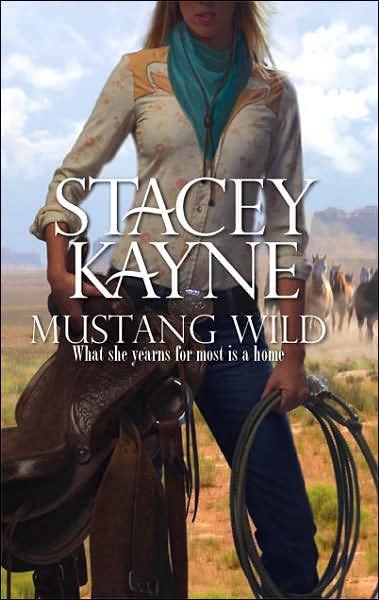
No smooth-talking man is going to outwit her!
With the deed to her land and kid brother to protect, Mustanger Skylar Daines shouldn’t have tangled with the likes of Tucker Morgan. His stolen kiss scatters her senses, and quicker than a whirling dust devil, they’re wed!
What had started as a joke is now Tucker’s worst nightmare. He’s keen to fix the marital slip-up–then he tells Skylar the deed she holds belongs to him, and him alone.
Perhaps Skylar shouldn’t be so fast to have their marriage annulled. She’s not about to be swindled out of the one thing she yearns for most–a home.
First they’ll have to beat her father’s murderer to Wyoming. Hearing the killer is after his ranch, Tucker teams up with a woman who has no trouble taking control of his mustangs–or his desire.
KIRSTEN’S THOUGHTS: MUSTANG WILD is fun, intense, sensual, and just plain entertaining. Stacey Kayne takes you right on the trail herding mustangs in the Old West with villains and nature plotting against Skylar and Tucker at every turn and their siblings not doing a whole lot to help out the situation (other than adding humor for the reader and grief to Skylar and Tucker).
Skylar is such a great heroine. She’s tough, determined, honorable and her desire to settle down and provide a home for her and her brother will hit you in the heart. I love how she proves her skill training mustangs to Tucker, and she doesn’t rub it in how good she is, she just does her job and does it better than most. It was tender to watch her shift from tough cowgirl to tender mother figure for her brother and soft woman with Tucker (when she didn’t want to shoot him).
Tucker is so charming it should be illegal, and although his natural instinct is to protect Skylar he respects her skills and comes to admire her for more than just her talent with horses. He’s a bit of the irresponsible brother, but once he sets his mind to making Skylar his hold onto your hats he’s all business and determined to win. Readers will be as helpless as Skylar to resist all that charisma when this devastatingly good looking cowboy turns it on.
The trail to Wyoming in dangerous, but the real danger is these two stubborn people losing their hearts!
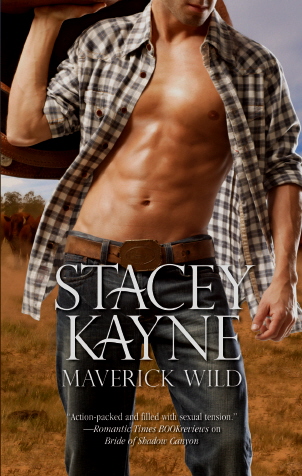 A promise from his past threatens what Chance values most…his freedom A promise from his past threatens what Chance values most…his freedom
Cora Mae Tindale isn’t looking to stir up trouble—she just needs a safe place to hide while she plans out her future. Having escaped the marriage trap set by her conniving mother, she’s arrived in the wilds of Wyoming searching for the stepbrother who promised to always protect her. She hadn’t counted on the boy from her childhood becoming a war-hardened rancher with heart-stopping looks that could tempt a saint.
Plagued by horse thieves and marriage-minded females, the last thing Chance Morgan needs is a woman on his ranch. But Cora Mae is more than just a pretty face—she’s part of his past; a reminder of the guilt and broken promises he’s spent too many years trying to forget. A distracting array of curls and curves, she hardly resembles the mischievous spitfire from his youth, but her eyes hold the shadows of a painful past, and a passion she struggles to conceal. Cora Mae’s indifference entices Chance in a way that blatant flirtation never could. He yearns to discover the truth she hides, but will uncovering her secrets expose his own?
KIRSTEN’S THOUGHTS: Chance is a tough, gruff, stubborn cowboy who values his independence above everything, so you know he’s going to fall hard for sweet Cora Mae. He might growl around a bit, but moments with his nephew, Skylar and Cora Mae give us a look at the real man who’s loyal to a fault and sweet when he needs to be.
Cora Mae can’t out ride most men, like Skylar, and she can’t out shoot and out survive most anyone, like Maggie. But she has just the right kind of grit to escape her mother and track her stepbrother to the wilds of Wyoming. And since Chance needs all the sweetness and gentleness he can get Cora Mae is the perfect match for him. But don’t worry, she’s no pushover and has no problem telling him exactly where he can ride his horse when he needs a good slap on the back of the head, too.
MAVERICK WILD keeps the fun and romance going that Tucker and Skylar started in MUSTANG WILD, but adds a new suspense as Chance and Cora Mae face cattle thieves, a manipulative mother/stepmother and a cunning widow. These two have their work cut out for each other as they find their way back to where they belong…with each other.
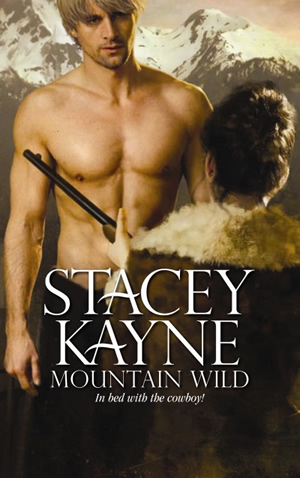
In the midst of a range war, Garret Daines is dead-set on keeping his ranch from greedy local cattle barons. An attempt on his life during a winter storm lands him in the healing hands of a mountain recluse. He can hardly believe the youthful beauty he discovers hidden beneath her mountain woman attire or the passion unleashed by her tender touch.
When “Mad Mag” pulls the handsome rancher from the snow she has no idea he’ll be the man to thaw her wounded heart. But Maggie is hiding a mess of secrets in her mountain sanctuary, none of which she’s willing to share. Murderous cattlemen threaten their fragile bond and Maggie has to face the fears of her past or risk losing her hope for the future. Garret will defend his wild woman at any cost, but can he convince her their love is worth the risk?
KIRSTEN’S THOUGHTS: I know I shouldn’t play favorites in the series, but doggonit it’s my blog! MOUNTAIN WILD melted me like butter. In fact, I’ll go one better, Garret and Maggie are still two of my favorite characters ever.
When we first meet Garret he’s Skylar’s cocky little brother, but even then he’s a charmer. And whoa doggies, when brother grows up he grows up in all the right ways. He’s strong and steady and so sweet and funny you can’t help but love him. His determination to make his own way and earn the respect of his family keeps you pulling for him. Unlike Tucker and Chance, Garret wants love, marriage, family (and has since MAVERICK WILD) and it made him a stronger hero for desiring those things and fighting to show Maggie how much better they were together.
Maggie just touched my heart from the start, even under all her animal skins and floppy hat. I already liked this character from MAVERICK WILD, but the more you get to know her the more you see how wounded and desperate she is for tenderness and sweetness (things Garret excels at), and how much she would like to be a part of Garret’s world, but fears giving up her freedom and the rejection she might face. It doesn’t take long, for the reader or Garret, to see her mountain shrew act, is just that, a show to protect her heart.
Like MUSTANG WILD and MAVERICK WILD, MOUNTAIN WILD has enough suspense and action to keep you enthralled, but at the end it’s the romantic tension that will keep you turning pages and then cursing yourself for reading it too fast.
Seriously folks, this is a must read series. Tucker, Skylar, Chance, Cora Mae, Garret, and Maggie will capture your heart. With each book you’ll change your mind about who your favorite cowboy is and then change it back again depending on who’s talking. I have rarely read a book where the heroine didn’t at some point annoy me, or I wished the cowboy would ride off into the sunset alone. Well, with the Wild Series I found three women who I cheered for all the way and was ecstatic when they lassoed their man. And Stacey Kayne does a magnificent job of giving each character a very distinct and real voice. Once you meet her people, she could remove all tags and a reader would know without hesitation who is speaking, or acting a certain way.
Stacey Kayne masterfully pulls together people and places so you almost feel like the gang is welcoming into their home and personally sharing their love stories. When you’re done reading you’ll be surprised you haven’t been in Wyoming sitting before a roaring fire and chatting with the Morgans and Daineses. This is a “put high on the keeper shelf” series ‘cause you will want to visit this clan over and over.
MUSTANG WILD (AMAZON) MAVERICK WILD (AMAZON) MOUNTAIN WILD (AMAZON)
MUSTANG WILD (NOOK) MAVERICK WILD (NOOK)
If you’re begging for more Stacey Kayne after you’ve read the Wild series, and you will be, here are two more fabulous stories filled with heart stopping cowboys and their brave women worthy of their own feature, but hey I’ve got chores.
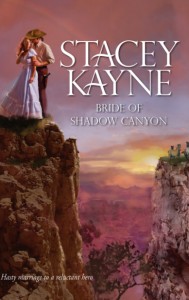 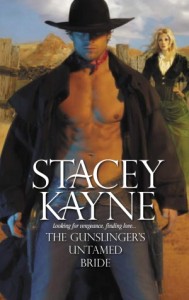
Continuing on down the trail from the majestic Tetons, this week we’re lookin’ at a whole different kind of spectacle. Let’s talk rodeo folks!! And if we’re talkin’ rodeo we must be  talkin’ the largest outdoor rodeo in the world. The Daddy of ‘Em All…Cheyenne Frontier Days! talkin’ the largest outdoor rodeo in the world. The Daddy of ‘Em All…Cheyenne Frontier Days!
YEEE-HAAAW!! Strap on your spurs we’re in for a rip snortin’, six-shootin’, bronc bustin’, bull riden’, steer ropin’, bulldoggin’ thrills and chills ride!
Acting on a suggestion from Frederick W. Angier, Traveling Passenger Agent of the Union Pacific Railroad, in 1897 plans for the first “Frontier Day,” were formulated in the Trivoli Saloon at the corner of 16th Street and Carey (the Saloon serves as the present day Chamber of Commerce). On September 23, 1897, a legacy of the old west began with the first Frontier Day.
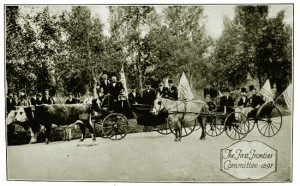 Flags decorated the town and a special excursion train brought in a band and visitors. The Sun-Leader reported on the “thousands of visitors from all over the state and from Colorado and Nebraska.” The first Frontier Day presented ox teams, vigilantes, and stage holdups as major parts of the presentation. The first Frontier Day parades consisted merely of cowboys racing down the street “perhaps scaring women, children and dogs.” The first celebration only lasted one day. It started at noon with a cannon fired by Battery A of the 76th Field Artillery and concluded with a Grand Ball at Keefe Hall. Flags decorated the town and a special excursion train brought in a band and visitors. The Sun-Leader reported on the “thousands of visitors from all over the state and from Colorado and Nebraska.” The first Frontier Day presented ox teams, vigilantes, and stage holdups as major parts of the presentation. The first Frontier Day parades consisted merely of cowboys racing down the street “perhaps scaring women, children and dogs.” The first celebration only lasted one day. It started at noon with a cannon fired by Battery A of the 76th Field Artillery and concluded with a Grand Ball at Keefe Hall.
Bill Jones won the saddle bronc contest, and the only marring incident on the first Frontier Day was when bleachers were smashed by wild horses, which had broken loose and spectators fled for safety. The following year William F. Cody’s “Wild West Show and Congress of Rough Riders of the World” attracted an audience of 6,000 to the festivities. The event was such a success it was expanded to two days, but continued to be referred to as “Frontier Day” until 1910.
 Frontier Day gained national attention in 1904 with the spectacular performance by black cowboy Will Pickett. Pickett, who is credited for single-handedly inventing the Bulldogging contest, observed that cowdogs would bring steers down by biting the steer on the muzzle. Thus Pickett would, “attack a fiery, wild-eyed, and powerful steer, dash under the broad breast of the great brute, turn and sink his strong ivory teeth into the upper lip of the animal, and throwing his shoulder against the neck of the steer, strain and twist until the animal, with its head drawn on way under the controlling influence of those merciless teeth and its body forced another, until the brute, under the strain of slowly bending neck, quivered, trembled and the sank to the ground.” Frontier Day gained national attention in 1904 with the spectacular performance by black cowboy Will Pickett. Pickett, who is credited for single-handedly inventing the Bulldogging contest, observed that cowdogs would bring steers down by biting the steer on the muzzle. Thus Pickett would, “attack a fiery, wild-eyed, and powerful steer, dash under the broad breast of the great brute, turn and sink his strong ivory teeth into the upper lip of the animal, and throwing his shoulder against the neck of the steer, strain and twist until the animal, with its head drawn on way under the controlling influence of those merciless teeth and its body forced another, until the brute, under the strain of slowly bending neck, quivered, trembled and the sank to the ground.”
Pickett’s performance was reported nationally in Harper’s Weekly and he was offered a place in the Miller Bros. 101 Wild West show. He was the first black man inducted into the Rodeo Cowboy Hall of Fame.
Women, though participating in rodeos since the 1880s, made their first appearance in the Frontier Day rodeo in 1904. Bertha Kaepernick gave and exhibition of bronc riding.
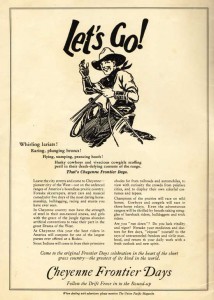 By 1908, Cheyenne Frontier Day, was recognized as the premier rodeo in the United States and cowboys from all over the country came to compete. That year the citizens of Wyoming were shocked by at least two of these out of state cowboys. The Basin, Wyoming newspaper The Big Horn County Rustler reported, in their August 28th edition, “for the first time in history neither the world’s champion bronc buster or steer roper was from Wyoming, also neither man was a resident of the group of states immediately surrounding Wyoming.” The steer roping champion was Ikua Purdy of Hawaii. By 1908, Cheyenne Frontier Day, was recognized as the premier rodeo in the United States and cowboys from all over the country came to compete. That year the citizens of Wyoming were shocked by at least two of these out of state cowboys. The Basin, Wyoming newspaper The Big Horn County Rustler reported, in their August 28th edition, “for the first time in history neither the world’s champion bronc buster or steer roper was from Wyoming, also neither man was a resident of the group of states immediately surrounding Wyoming.” The steer roping champion was Ikua Purdy of Hawaii.
The bronc riding champion that year was Dick Stanley of Portland, Oregon. Stanley won the championship “by the most splendid exhibition of horsemanship ever seen in a frontier arena…Stanley performed a feat never before accomplished by a buster, riding to finish old Steamboat and spurring the horse at every jump. Many men have ridden old Steamboat for years the undisputed worst bucker of the world, but never before did a rider spur the equine warrior and manage to remain on his back until he was subdued.”
After his death in 1910, it was discovered that Dick Stanley was really, Earl Carl Shobe, and he had jumped bail in Wyoming some years before on charges of murder and post office robbery.
Steamboat continued to compete until John Coble sold out. He donated Steamboat to the Cheyenne Elks Lodge. In 1914, Steamboat contracted blood poisoning from a barbed wire fence and met his end. The horse was inducted into the Pro-Rodeo Hall of Fame in 1979.
Legends, both man and beast, continued to be made at Frontier Park and cowboys from around the country enter to test their metal at the Daddy.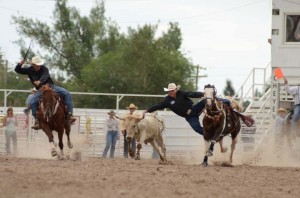
The Basin Republican reported in July 1909, “entries are still coming in for various events at Frontier and judging from the official program…there will be more contests and more interesting features than ever before. Six fine band [sic] have been engaged to supply music, and in addition to the purely wild west sports, Uncle Sam’s crack Ninth Cavalry will do some special stunts…”
Only war could threaten the Daddy, but after World War I ended the question on the people of Cheyenne’s mind was whether there would be Frontier Days. In November 1918, the Wyoming State Tribune put their minds to ease. “With the War over, troop movements stopped, and many of the best performers who have been in the army probably out, and ready to appear again by the time the show is held, things are said to be looking up for a good Frontier celebration next summer.” Trains were running under normal conditions without troop and munitions being transported, so tourists could once again travel West.
One blight caused concern for the success of that year’s show. Prohibition. How would being a dry state effect people’s desire to come to Cheyenne “a wide open town in the minds of many…They come to frontier [sic] to see a wide open cow town, and when the town is no longer that, the effect on the number of people who come here for the show forms a subject of much speculation.” They didn’t speculate too long, and in July 1919 Frontier Days was held in all its pageantry to large crowds.
Parades, concerts, pancake breakfasts, Indian dancers, the largest outdoor rodeo in the world, and more cowboys than you can lasso in a year, the Daddy of ‘em All never disappoints. So put it on your bucket list, or better yet high tail it to Cheyenne this July and live the experience.
 And while you’re in the neighborhood mosey on over to Fort Laramie or the Wyoming Territorial Prison and Old West Park. And while you’re in the neighborhood mosey on over to Fort Laramie or the Wyoming Territorial Prison and Old West Park.
Whatever you do, get a move on pilgrims and get your hides down to old Cheyenne!
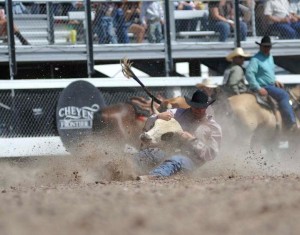
Sources
“Basin Republican.” July 27, 1909. page 1
“Big Horn County Rustler.” August 28, 1908. page 1
“Wyoming State Tribune.” No. 288. November 20, 1918. page 6.
Wyoming Tales and Trails. http://www.wyomingtalesandtrails.com/frontierdays.html
Kirsten Lynn @ 2012
YEEEE-HAW!!! Y’all will wanna turn that nag around and head over to the campfire today for sure. Today, I’m featuring books by Cheryl Pierson and Elizabeth Lane two authors who know their cowboys and what makes a story ace-high.
To make this a regular hog killin’ time, Cheryl Pierson offered to giveaway a copy of all her stories mentioned today!! So Cookie will be hoppin’ tonight pulling FOUR names out of the hat!
Now let’s get all the ballyhoo taken care of before we get to the fun. Leave a good e-mail address (where required) for a chance to win. **E-copies only of all prizes for foreign winners.** The first name out of the hat wins a copy of TIME PLAINS DRIFTER (autographed print copy or e-book choice for U.S. winner, e-book for foreign winner). The other three winners will receive an e-book copy of one of Cheryl Pierson’s short stories featured!
Since my trusty nag, wordpress, gave me the slow roll this mornin’ I’m gonna extend the contest and won’t draw the winner ’til first light tomorrow. So commence to commentin’!
Now let’s get on to the good stuff! (Remember bold print is official blurb my comments trail behind)
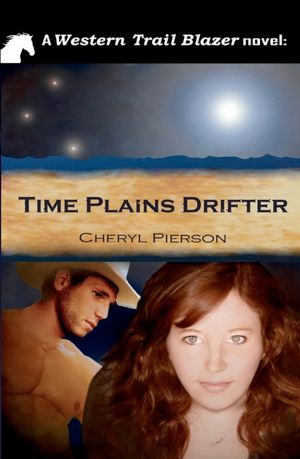 Trapped in Indian Territory in 1895 by a quirk of nature, high school teacher Jenni Dalton must find a way to get her seven students back to 2010. Handsome U.S. Marshal Rafe d’Angelico seems like the answer to her prayers: he is, after all, an Angel. In a race against time and evil, Rafe has one chance to save Jenni’s life and her soul from the Dark One – but can their love survive? Trapped in Indian Territory in 1895 by a quirk of nature, high school teacher Jenni Dalton must find a way to get her seven students back to 2010. Handsome U.S. Marshal Rafe d’Angelico seems like the answer to her prayers: he is, after all, an Angel. In a race against time and evil, Rafe has one chance to save Jenni’s life and her soul from the Dark One – but can their love survive?
If you enjoy time travel stories read TIME PLAINS DRIFTER! If you’ve never read a time travel book, or don’t think you want to…READ TIME PLAINS DRIFTER! The time travel is the most realistic explanation for time travel I’ve read and then you add in the paranormal elements tied to Rafe, and really Cheryl Pierson lassoed it all together so beautifully you just have to read it. Rafe d’Angelico is rugged, tortured, and swoon worthy (I actually swooned… more than once) the perfect old West lawman. Jenni, from present day Oklahoma, is gutsy and determined enough to hold her own in 1895 Indian Territory. The only thing I can say against Jenni is she gets Rafe, and here I was reading up on time travel methods. The secondary characters are legendary, and if Rafe and Jenni weren’t such a fantastic hero and heroine the others could steal the show. Heart pounding action scenes and love scenes, good versus evil (and did I mention a swoon worthy hero) make TIME PLAINS DRIFTER a must read!
Time Plains Drifter (Amazon) Time Plains Drifter (Nook)
Don’t forget to check out Cheryl’s other fabulous stories available at Amazon, Barnes and Noble, and Smashwords! Westerns, Western Romance, and Contemporary you won’t be disappointed in any of this author’s works. I couldn’t choose just one so below are three of my favorites from her short story collection. But JASON’S ANGEL gets a special tip of my hat. This story could have been five hundred pages and I’d still want more. 

HOMECOMING
 EVERY GIRL’S DREAM EVERY GIRL’S DREAM
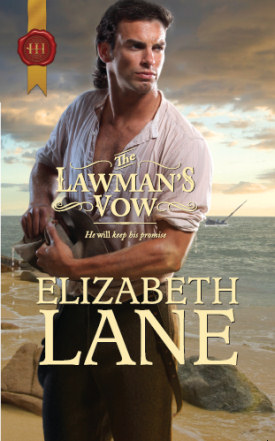 San Francisco Lawman Flynn O’Rourke swore he’d bring his sister’s killer to justice. So when suspect Aaron Cragun is identified, Flynn will do anything, even rent a boat and sail to Cragun’s remote home to find him. But Flynn doesn’t anticipate the storm that wrecks his boat, the injury that erases his memory…or the beautiful woman who rescues him. San Francisco Lawman Flynn O’Rourke swore he’d bring his sister’s killer to justice. So when suspect Aaron Cragun is identified, Flynn will do anything, even rent a boat and sail to Cragun’s remote home to find him. But Flynn doesn’t anticipate the storm that wrecks his boat, the injury that erases his memory…or the beautiful woman who rescues him.
Sweet Sylvie is loving and kind—and Aaron Cragun’s daughter. As Flynn’s memory returns, will the lawman keep his vow or allow himself to fall for the one woman forbidden to him?
THE LAWMAN’S VOW is MAGIC from the setting to the hero and heroine and the secondary characters. Elizabeth Lane brings readers a story to grab a cup of coffee or tea and get swept away. Flynn O’Rourke is kind, generous, but don’t worry he’s still tough enough to take on the bad guys. Oh, and did I mention he smolders (literally I smelled smoke and realized it was my Kindle). His interactions with Sylvie and her young brother are so tender you’re sure to melt. I was a bit worried when I read the blurb that Sylvie might be a bit flighty or annoying in her innocence, but Elizabeth Lane did a wonderful job of making Sylvie loving and innocent, but also an intelligent young woman whose strength is in her heart and her determination to protect those she loves. You end up rooting for these two to overcome all that stands between them and find their happily ever after. THE LAWMAN’s VOW is a bit different in that it’s not a shoot ‘em up Western, but this is a story you’re sure to enjoy!
The Lawman’s Vow (Amazon) The Lawman’s Vow (Nook)
Below are three of my favorites from Elizabeth Lane’s vast selection. You can find Elizabeth’s books on Amazon, Barnes and Noble, or e-Harlequin. I have to give special mention to CHRISTMAS MOON. I read this story in December and the characters are still with me. Winter, spring, summer, fall, I would recommend this book anytime. My only warning is  once you start reading you won’t stop. once you start reading you won’t stop.

THE STRANGER
 THE WIDOWED BRIDE THE WIDOWED BRIDE
It’s gettin’ on to summer time and pretty soon many of you will be loadin’ up supplies and the little tykes in the Conestoga and headin’ out on the trail. God bless ya’ll!
So, for the next few weeks I’m gonna feature a few places in the West I hold near and dear to my heart. Places I consider home, as do many of the characters in my manuscripts.
I can’t even count the number of times I’ve been to the location featured today, and I’ll probably go just as many times as I can in the future. It is truly one of the most beautiful places on God’s earth and if you haven’t been, well turn that wagon ‘round and get those mules headed West to Wyoming!
GRAND TETON NATIONAL PARK & JACKSON HOLE, WYOMING 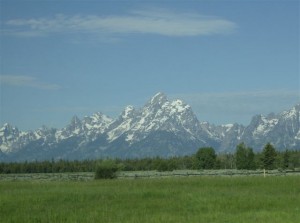
Named for the largest of the peaks the Grand Teton there are three peaks, the Grand, Middle and South Tetons.
Archeological studies show humans arrived in the Teton Range over 11,000 years ago. By the time the first white explorers entered the region in the early 19th Century it was the people of the eastern Shoshone tribes they encountered. For the modern Wind River Shoshone, who continue to maintain close cultural ties to this region, the majestic and snow-capped peaks of the Tetons hold special significance. “In the Shoshone belief system, mountain peaks provide access into the spirit world, where they gain special powers for such things as hunting or healing.”
The first white men who ventured into the Tetons were trappers and explorers. These men will be featured in future posts as each deserves a post to themselves and I’m not sure you’d appreciate a hundred page blog. So we’ll let John Colter, Jim Bridger, John Hoback, Edward Robinson, Andrew Henry, Jed Smith, Jacob Reznor and others take a breather, but we’ll meet them up on the trail a piece.
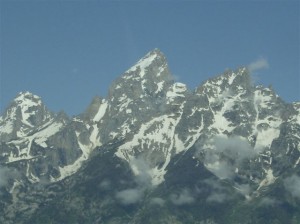 The Three Tetons, were among the most significant landmarks in the fur trade era. By the 1820s, the mountains were known as the Trois Tetons, the Three Paps, or the Three Tetons. It is unkown how these peaks received their names, however it is likely Iroquois or French Canadian trappers from the Pacific Northwest may have been responsible. Two trappers wrote of their first experience viewing these majestic peaks. Warren Ferris saw the Three Tetons for the first time, in 1831, from the Gray’s River south of Jackson Hole. He described them as “three inaccessible finger-shaped peaks of a lofty mountain overlooking the country to a vast distance. . . . Their appearing [sic] is quite singular, and they form a noted landmark in that region.” Osborne Russell viewed the Tetons for the first time from Pierre’s Hole, where they are most visible and distinct. From Russell’s vantage point, the range appeared as “Mountains piled on Mountains and capped with three spiral peaks which pierce the cloud.” The Three Tetons, were among the most significant landmarks in the fur trade era. By the 1820s, the mountains were known as the Trois Tetons, the Three Paps, or the Three Tetons. It is unkown how these peaks received their names, however it is likely Iroquois or French Canadian trappers from the Pacific Northwest may have been responsible. Two trappers wrote of their first experience viewing these majestic peaks. Warren Ferris saw the Three Tetons for the first time, in 1831, from the Gray’s River south of Jackson Hole. He described them as “three inaccessible finger-shaped peaks of a lofty mountain overlooking the country to a vast distance. . . . Their appearing [sic] is quite singular, and they form a noted landmark in that region.” Osborne Russell viewed the Tetons for the first time from Pierre’s Hole, where they are most visible and distinct. From Russell’s vantage point, the range appeared as “Mountains piled on Mountains and capped with three spiral peaks which pierce the cloud.”
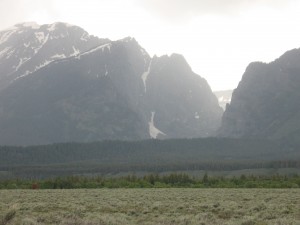 Trappers used the Three Tetons as guides to passes and trails through the valley. Two passes provided access through the Teton Range, Conant Pass, and Teton Pass. The latter pass was the most important. Other important passes were Togwotee, Union, and Two Ocean. Significant routes through the valley were the Hoback Trail, the Yellowstone, and the Gros Ventre River route. Because Jackson Hole is located between South Pass and the upper Snake River country, it was common for trappers to follow the Hoback or Gros Ventre Rivers from the Green River Basin, then cross Teton Pass. Parties traveling from the Bighorn Mountains in the east followed the Wind River and crossed into Jackson Hole via Union or Togwotee Pass. At Union Pass, trappers could turn south, strike the Green River and head south to other profitable trapping grounds. Mountain men entered or exited the Yellowstone country via the Lewis River or Two Ocean Pass. Trappers used the Three Tetons as guides to passes and trails through the valley. Two passes provided access through the Teton Range, Conant Pass, and Teton Pass. The latter pass was the most important. Other important passes were Togwotee, Union, and Two Ocean. Significant routes through the valley were the Hoback Trail, the Yellowstone, and the Gros Ventre River route. Because Jackson Hole is located between South Pass and the upper Snake River country, it was common for trappers to follow the Hoback or Gros Ventre Rivers from the Green River Basin, then cross Teton Pass. Parties traveling from the Bighorn Mountains in the east followed the Wind River and crossed into Jackson Hole via Union or Togwotee Pass. At Union Pass, trappers could turn south, strike the Green River and head south to other profitable trapping grounds. Mountain men entered or exited the Yellowstone country via the Lewis River or Two Ocean Pass.
In 1872, William H. Jackson took the first photographs of the Grand, Middle and South Teton. In the area to photograph Yellowstone, Jackson took a side trip to the Tetons as Yellowstone had lost something of its novelty. The Tetons, never before photographed, now became more important to Jackson. Jackson and a small party including his assistant, Charley Campbell, John Merle Coulter, the botanist, P J. Beveridge, and a packer named Aleck.
They ascended Table Mountain situated to the west of the three Tetons. The mules carried food and camp gear, while Jackson’s mule, “Old Molly,” hauled his precious photographic equipment. They set up camp at tree line, spent three days exploring the area, and sought a good vantage point for photographic work. While making their way to the summit of Table Mountain, they found their passage blocked by a wall of rock. “On one side was a sheer precipice, but on the other a ledge supported a bank of hard snow, ‘which offered a passage around the wall.’ ” The snowbank formed a dangerous angle, hanging over a sheer drop of several hundred feet. Deciding the risk was worth the view, they first packed a trail on the snow, then carefully guided their saddle and pack animals across the snowbank. Jackson’s photographs of the Grand Teton are among the most famous of his thousands of remarkable images of the American West. The Grand Teton was revealed to Americans for the first time.
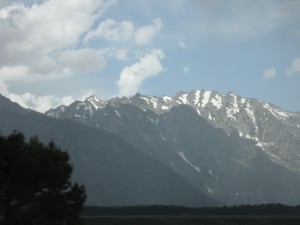 By the time, President Chester A. Arthur traveled through Jackson Hole in 1883 with a large entourage of guides, Indians, cavalrymen, packers, and political cronies, the purpose was recreation rather than exploration. A year after Arthur’s tour, the first settlers entered Jackson Hole, marking a new era in the valley’s history. By the time, President Chester A. Arthur traveled through Jackson Hole in 1883 with a large entourage of guides, Indians, cavalrymen, packers, and political cronies, the purpose was recreation rather than exploration. A year after Arthur’s tour, the first settlers entered Jackson Hole, marking a new era in the valley’s history.
After years of politics and social disagreements about how to preserve the Teton Range prominent Jackson Hole residents agreed on a plan to protect the Teton Range and six lakes at the base of the range. President Calvin Coolidge signed the executive order establishing the 96,000 acres Grand Teton National Park.
This is barely a thumbnail sketch of the history of the Teton area. But don’t fret, I’ll be covering more in future posts. If you can’t wait for me, a good sketch of the history can be found at www.nps.gov/grte/.
Or heck, treat yourself to a first hand look and don’t forget to visit the towns of Jackson and Dubois while you’re up there. It’s a sight that hits me right in the heart and soul every time. That moment when from a basin blanketed in snow or wild grasses, sage,and flowers rises three peaks touching a vast clear blue sky or their tips hidden by clouds heavy with snow or rain. I always say I don’t need any more pictures of the Tetons, and I always end up taking hundreds more.
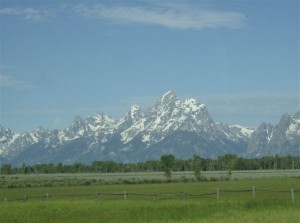 *Information on the Park provided by “A Place Called Jackson Hole.” Daugherty, John. Grand Teton Natural History Association. Moose, Wyoming. 1999. *Information on the Park provided by “A Place Called Jackson Hole.” Daugherty, John. Grand Teton Natural History Association. Moose, Wyoming. 1999.
**The pictures provided on this page are my own from my last visit to the Tetons** 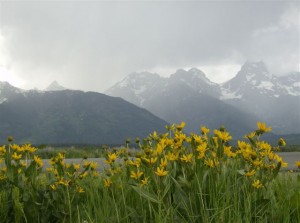
|
|
 In Southwest Johnson County, Wyoming lying between the Red Wall and Big Horn Mountains is the most famous hideout on the Outlaw Trail, the Hole-in-the-Wall. Between roughly the 1860s and 1910, 30 to 40 outlaws stayed in the secluded spot including Jesse James and Butch Cassidy’s Wild Bunch.
In Southwest Johnson County, Wyoming lying between the Red Wall and Big Horn Mountains is the most famous hideout on the Outlaw Trail, the Hole-in-the-Wall. Between roughly the 1860s and 1910, 30 to 40 outlaws stayed in the secluded spot including Jesse James and Butch Cassidy’s Wild Bunch.  The area was (and still is) isolated taking about a day’s journey by horseback from any semblance of civilization. It is a steep climb to the top of the Wall, but overlooking the country below it is no wonder this location was chosen. With sweeping 360 views the pass was well situated to spot approaching lawmen and the narrowness of the approach made it easy to defend. The grassy plateau at the top and creek bed of the canyon below made it a good spot to graze all the rustled cattle.
The area was (and still is) isolated taking about a day’s journey by horseback from any semblance of civilization. It is a steep climb to the top of the Wall, but overlooking the country below it is no wonder this location was chosen. With sweeping 360 views the pass was well situated to spot approaching lawmen and the narrowness of the approach made it easy to defend. The grassy plateau at the top and creek bed of the canyon below made it a good spot to graze all the rustled cattle. In this area in the 1880s and 1890s, rustlers grazed stolen cattle and provided refuge to outlaws. Inhabitants of the six cabins that stood in the valley were known as the Hole-in-the-Wall Gang. Members of the gang included Bob Smith, Al Smith, Bob Taylor, George Currie, Tom O’Day, and the Roberts Brothers. Later Robert Leroy Parker (Butch Cassidy), Harry Longbaugh (the Sundance Kid), and Harvey Alexander Logan (Kid Curry).
In this area in the 1880s and 1890s, rustlers grazed stolen cattle and provided refuge to outlaws. Inhabitants of the six cabins that stood in the valley were known as the Hole-in-the-Wall Gang. Members of the gang included Bob Smith, Al Smith, Bob Taylor, George Currie, Tom O’Day, and the Roberts Brothers. Later Robert Leroy Parker (Butch Cassidy), Harry Longbaugh (the Sundance Kid), and Harvey Alexander Logan (Kid Curry). As we make our way up the rugged trail, let me introduce y’all to our hosts. Robert Leroy Parker, born in 1866, was the son of devout Mormons. He was led into a life a crime by Mike Cassidy and adopted the name George Cassidy, some believe as a way of not bringing shame on his family. In 1885, Mike Cassidy disappeared after killing a Wyoming rancher. Parker took a job with Charlie Crouse. Crouse operated a ranch in Brown’s Hole and a butcher shop in Rock Springs, Wyoming. It was alleged Crouse sold meat from cattle he rustled. It was while employed by Crouse, Parker adopted the name Butch.
As we make our way up the rugged trail, let me introduce y’all to our hosts. Robert Leroy Parker, born in 1866, was the son of devout Mormons. He was led into a life a crime by Mike Cassidy and adopted the name George Cassidy, some believe as a way of not bringing shame on his family. In 1885, Mike Cassidy disappeared after killing a Wyoming rancher. Parker took a job with Charlie Crouse. Crouse operated a ranch in Brown’s Hole and a butcher shop in Rock Springs, Wyoming. It was alleged Crouse sold meat from cattle he rustled. It was while employed by Crouse, Parker adopted the name Butch. he participated in the robbery of the San Miquel Valley Bank in Telluride in June of 1889. The Telluride robbery saw the introduction of a new tactic used by members of the Wild Bunch. Along the escape route, the robbers stationed fresh horses. The pursuing posse would have to continue the chase on tired horses, therefore the robbers could elude capture.
he participated in the robbery of the San Miquel Valley Bank in Telluride in June of 1889. The Telluride robbery saw the introduction of a new tactic used by members of the Wild Bunch. Along the escape route, the robbers stationed fresh horses. The pursuing posse would have to continue the chase on tired horses, therefore the robbers could elude capture. Our second host is Harry Longabough. Born in Pennsylvania in 1867, he moved to Colorado with his family. By age twenty, Longabough was working as a cowboy for the N Bar N owned by the Neidringhaus Brothers in Culbertson, Montana. In 1887, out of work and drifting he stole a horse, gun and saddle from Western Ranches, Ltd, owner of the Three V’s near Sundance, Wyoming. He was arrested and pleaded guilty, and was sentenced to 18 months in the Sundance jail. He was pardoned by Governor Thomas Moonlight. Longabough drifted to Bell Fourche, South Dakota, and there as a result of his bravado about the time spent in the Sundance jail he earned the appellation of Sundance or Sundance Kid.
Our second host is Harry Longabough. Born in Pennsylvania in 1867, he moved to Colorado with his family. By age twenty, Longabough was working as a cowboy for the N Bar N owned by the Neidringhaus Brothers in Culbertson, Montana. In 1887, out of work and drifting he stole a horse, gun and saddle from Western Ranches, Ltd, owner of the Three V’s near Sundance, Wyoming. He was arrested and pleaded guilty, and was sentenced to 18 months in the Sundance jail. He was pardoned by Governor Thomas Moonlight. Longabough drifted to Bell Fourche, South Dakota, and there as a result of his bravado about the time spent in the Sundance jail he earned the appellation of Sundance or Sundance Kid. business. Harvey Alexander Logan was born in Iowa in 1867. After their mother died the four Logan boys, Hank, Johnnie, Lonny, and Harvey moved to Missouri and lived with an aunt. With Johnnie and Lonny, and a cousin, Harvey Logan left home to trail cattle from Texas to Colorado. The four ultimately wandered to the Hole-in-the-Wall where they met George Currie and adopted the last name “Curry.”
business. Harvey Alexander Logan was born in Iowa in 1867. After their mother died the four Logan boys, Hank, Johnnie, Lonny, and Harvey moved to Missouri and lived with an aunt. With Johnnie and Lonny, and a cousin, Harvey Logan left home to trail cattle from Texas to Colorado. The four ultimately wandered to the Hole-in-the-Wall where they met George Currie and adopted the last name “Curry.” On the outlaw trail, Harvey fell in with Butch and Sundance and participated in the Wilcox and Tipton, Wyoming train robberies…
On the outlaw trail, Harvey fell in with Butch and Sundance and participated in the Wilcox and Tipton, Wyoming train robberies… There the express car was surrounded, and the attendant, E.C. Woodcock, was ordered to open the door. He refused. The car was blown up. Woodcock suffers a concussion from the blast and can’t remember the combination to the safe. The gang blows up the safe and stole $30,000, some of the bank notes being scorched by the explosion or stained with raspberries also in the car.
There the express car was surrounded, and the attendant, E.C. Woodcock, was ordered to open the door. He refused. The car was blown up. Woodcock suffers a concussion from the blast and can’t remember the combination to the safe. The gang blows up the safe and stole $30,000, some of the bank notes being scorched by the explosion or stained with raspberries also in the car. Of all the Wild Bunch members Etta Place is the most mysterious. She is one of the Wild West’s most legendary women. Beautiful and wild she is reported to have been mistress to both Butch Cassidy and Sundance. Eyewitnesses maintain she was the second woman to ride into Robber’s Roost in the winter of 1897. She was allegedly 20 years old at the time, strikingly beautiful, an excellent horsewoman, and outstanding rifle shot, Etta became Sundance’s primary love interest.
Of all the Wild Bunch members Etta Place is the most mysterious. She is one of the Wild West’s most legendary women. Beautiful and wild she is reported to have been mistress to both Butch Cassidy and Sundance. Eyewitnesses maintain she was the second woman to ride into Robber’s Roost in the winter of 1897. She was allegedly 20 years old at the time, strikingly beautiful, an excellent horsewoman, and outstanding rifle shot, Etta became Sundance’s primary love interest. Today, a rugged dirt road leads from ranch headquarters to the former hideout. Guests can walk threw the chunks of foundation remaining. Guests can picnic beneath the old cottonwoods by Buffalo Creek and dream of the days when Butch, Sundance and the gang would seek refuge at the Hole-in-the-Wall.
Today, a rugged dirt road leads from ranch headquarters to the former hideout. Guests can walk threw the chunks of foundation remaining. Guests can picnic beneath the old cottonwoods by Buffalo Creek and dream of the days when Butch, Sundance and the gang would seek refuge at the Hole-in-the-Wall. Okay folks, we’re gettin’ close so get yer hand off the heel of your gun before ya get us all blown to bits. Smile big and look like ya belong! It’s sure to be a high kickin’ time with this bunch!
Okay folks, we’re gettin’ close so get yer hand off the heel of your gun before ya get us all blown to bits. Smile big and look like ya belong! It’s sure to be a high kickin’ time with this bunch!

























































